Ozone 9 Elements Help
Introduction

New in Ozone Elements
- Updated interface and fluid metering.
- Updated UI/UX in the Equalizer module.
- New Imager Stereoize mode.
- Updated Master Assistant UX.
- Resizable plug-in window.
Getting Started
Table of Contents
Navigating the Plug-in Interface
The Ozone Elements plug-in interface is divided into the following main sections:

- Global Header: Includes Master Assistant, Global Presets, Undo History, Options, and Help.
- Signal Chain: Displays the contents and order of the processing chain. Each module tile includes: Bypass, Solo, Module Presets, and a difference level meter.
- Module Interface: Controls and meters associated with a specific processing module.
- I/O Panel: I/O (Input/Output) gain and metering, Bypass, and some auditioning features.
Learn more
See the General Controls chapter for more information about the controls included in the main areas of the Ozone interface.
Quick Start Suggestions
Not sure where to start? You can try using presets or using Master Assistant to get going quickly with Ozone Elements.
Using Presets
Ozone includes a wide variety of factory presets to help get you started on your master. You can load and save settings in all modules using the global preset manager or in each individual module using the module preset manager.
Using Master Assistant
The intelligent Master Assistant feature allows you to quickly to develop an intelligent starting point for your master. Learn more about working with Master Assistant in the Master Assistant chapter.
Authorization
The first time you open Ozone 9 Elements, the Authorization window will appear.

The Authorization window allows you to:
- Run Ozone Elements in Trial mode: Start or continue a Trial period evaluation prior to purchasing.
- Run Ozone Elements in Demo mode: Continue evaluating the product with feature limitations (after your 10 day trial period has expired).
- Authorize Ozone Elements with your serial number.
Trial Mode
Trial mode allows you to evaluate Ozone 9 Elements with full functionality for 10 days. The trial period begins the first time you open the Ozone 9 Elements plug-in. The Authorization window will display the number of days remaining in your trial period. Click the Continue button to start or continue working with Ozone in trial mode.
Demo Mode
When your 10 day trial period has expired, you can continue using Ozone with demo limitations. To continue evaluating Ozone 9 Elements in demo mode, click the Demo button in the Authorization wizard.
Demo Mode Limitations
Ozone 9 Elements will periodically output silence when operating in demo mode.
Authorize Ozone Elements
To disable Trial or Demo mode, you need to authorize the product with a valid serial number. You can choose from three different authorization methods:
- Online Authorization: Authorize Ozone Elements on a computer that is connected to the internet at the time of authorization.
- Offline Authorization: Authorize Ozone Elements on a computer that is not connected to the internet at the time of authorization.
- iLok Authorization: Authorize Ozone Elements by storing your authorization on an iLok USB key.
Authorization Help
For additional help authorizing Ozone, check out the Installation and Authorization help section of the iZotope Support knowledgebase.
General Controls
Overview
This chapter includes information about general controls and functions you can find in Ozone.
Resizing
You can resize the window by clicking and dragging the bottom right corner of the Ozone interface.
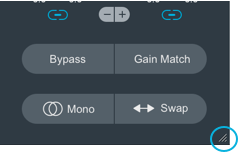
Header controls
The Ozone header area includes the following features:

- Master Assistant: Opens the Master Assistant panel.
- Presets Opens the Global Preset manager window.
- Previous/Next preset: Loads the previous/next preset in the preset list.
- Undo: Reverts the most recent parameter change.
- Undo history: Opens the Undo History window. See the Undo History section below for more information.
- Options: Opens the Options window.
- ? (Help): Opens the installed Ozone help documentation in your default web browser.
Undo History
The Undo History window allows you to view a list of recent parameter changes made in the current instance of Ozone, compare different parameter states in the history list, or reset Ozone’s settings to a given point in the history list.
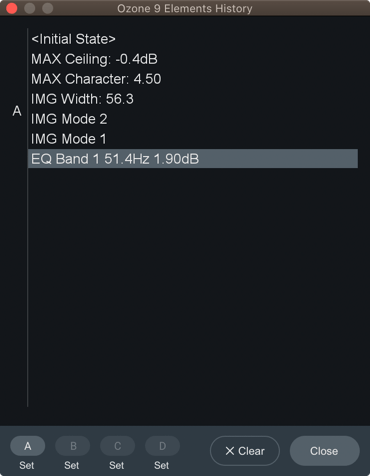
- CLEAR: Removes all actions from the history list. Clearing the history list does not affect parameters, it simply removes existing entries from the list.
- CLOSE: Hides the Undo History window.
- A/B/C/D: Allows you to set four history snapshot states. Snapshots allow you to quickly toggle between different processing states to compare changes. Assign an event in the history list to a snapshot button by selecting the event in the list and clicking the “Set” button below a snapshot button.
Signal Chain
The following image outlines the controls and features available in the signal chain area:
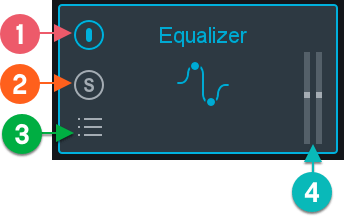
- Power: Enables/disables processing for the associated module.
- Solo: Disables all other module processing and isolates the associated module.
- Module presets: Opens the module preset manager window for the associated module.
- Difference meters: Displays the amount of gain change introduced by processing in the associated module.
I/O Panel
The I/O panel is split into two main sections:
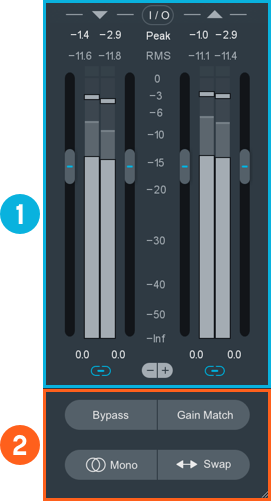
Input/Output Gain and Meters
The following image outlines the input and output metering and gain controls available in Ozone.
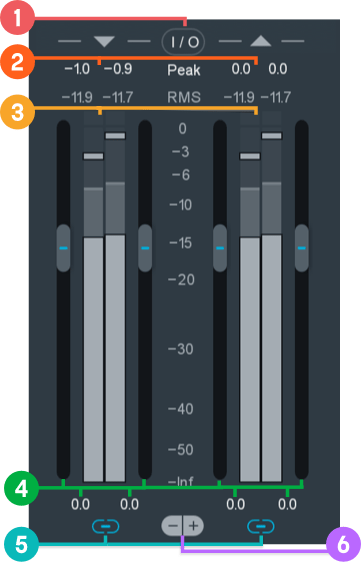
- I/O Meter Options
- Input/Output level readouts: Shows the current or max input levels, according to the selected meter type.
- Input/Output meters: Displays input/output level information according to the I/O meter option configuration.
- Input/Output gain: Adjusts the amount of gain applied to the input/output signal.
- Link: Links/unlinks adjustments of left and right I/O gain controls.
- - | +: Decreases or increases the resolution of the meter scale.
Clipping Indicators
When the input or output signal exceeds 0 dBFS, the clipping indicator box and level readout text above the meters will be displayed in red.

You can click on the red readout text and/or clipping indicator box to reset the clipping indicator.
I/O Meter Options
Click on the I/O button above I/O meters to toggle the I/O Meter Options pop-over menu open and closed.
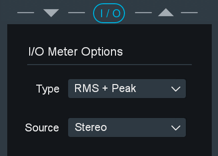
- Type: Selects the metering calculation used to display information in the input and output meters.
- Source: Selects between Stereo or Mid/Side metering displays the input and output meters.
More info
Learn more about the individual I/O meter Type and Source options in the Options chapter.
Global Processing and Auditioning
The section located directly below the I/O meters and gain controls includes:

- Bypass: Select to disable all processing in the current instance of Ozone.
- Sum to Mono: Sums the stereo output channels into a mono signal. Useful for checking mono compatibility.
- Gain Match: Toggle to enable/disable gain matching of the output signal. Behavior depends on the Enable legacy bypass gain match behavior setting in the Options window.
- Swap channels: Swaps the left and right output channel assignments.
Master Assistant
Overview
Master Assistant is designed to provide an intelligently tailored starting point for your track, to help you create a professional-sounding master, regardless of your experience level. Master Assistant utilizes target genre curves that were born from a mixture of internal discussion and research. We started by grouping a large variety of audio files into ten classes of musical genre. These genre classes were then analyzed for their spectral characteristics. Based on our research, we created a number of target curves that represent the typical spectral characteristics for each genre class. Master Assistant analyzes your track to determine how similar it is to the different genre curves. Each genre curve is assigned a percentage of similarity and the percentages are used to create a unique target curve for your track.
Workflow Steps
- Click the Master Assistant button in the header area to open the Master Assistant panel.

- Adjust the settings in the Master Assistant panel to suit your desired output. See the Master Assistant settings section below for details about the different options.
- Click Next to proceed to the Master Assistant analysis step.
- Analysis: Master Assistant requires audio input to perform analysis and adjust settings.
- Play your track for at least 30 seconds so that Master Assistant has enough time to analyze the input audio.
- Play the loudest portion of your track to achieve the best results.
- Enable loop playback in your DAW if you are analyzing a selection that is less than 30 seconds long.
- When Master Assistant is finished working, you can either Accept or Cancel the changes.
- Accept: Retains all changes made by Master Assistant and exits the Master Assistant panel.
- X (Cancel): Reverts all settings to the state they were in before running Master Assistant and exits the Master Assistant panel.
Master Assistant Settings
There are three main sections in the Master Assistant setup panel:
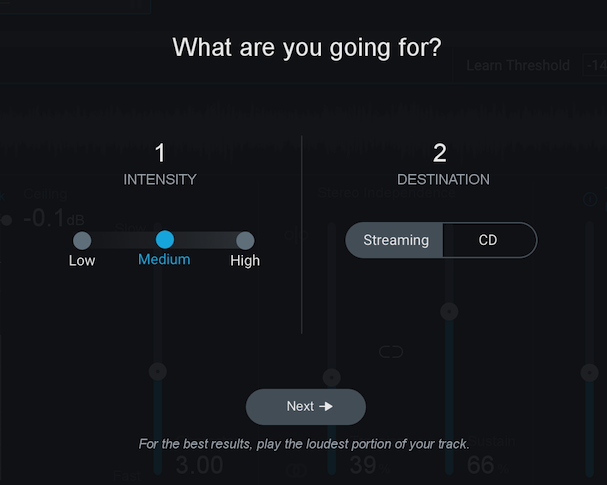
Intensity
Selects the target loudness value (in LUFS) used by Master Assistant. The following choices are available:
- LOW: -14 LUFS
- MEDIUM: -12 LUFS
- HIGH: -11 LUFS
Destination
Determines the Ceiling value in the Maximizer to ensure appropriate headroom for the selected destination format. The Destination options are associated with the following Ceiling values:
- Streaming: -1.0 dB
- CD: -0.3 dB
Equalizer
Table of Contents
Overview
Ozone’s versatile Equalizer allows you to add warmth and character with analog-matched filters, or precisely boost and cut frequencies with digital linear-phase filters.
The module interface includes the following sections:
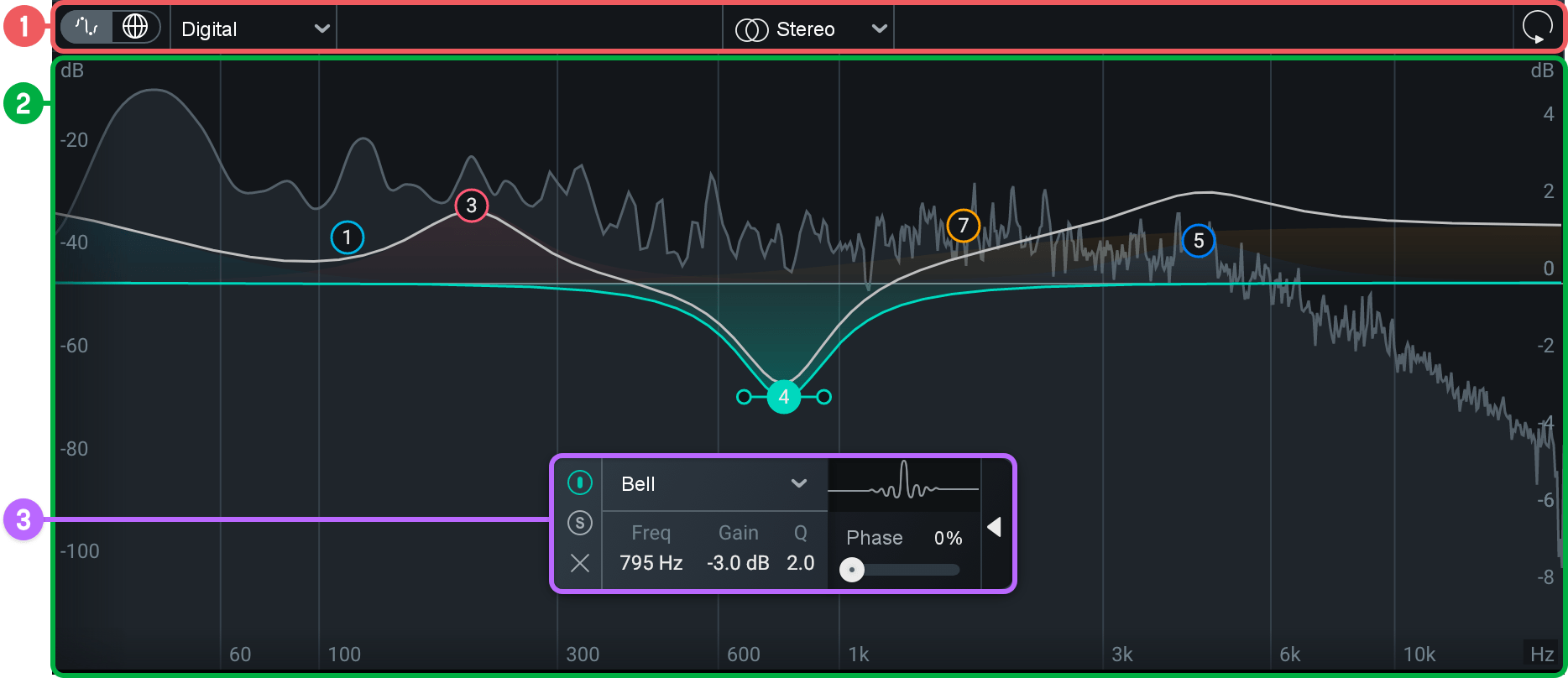
Module Header
The module header includes the following controls:

- View Selector: See the Views section below for detailed descriptions of the different views.
- Global Filter Mode: Selects the type of filter algorithm used to process all bands in the EQ module.
- Analog: Selects minimum-phase IIR (infinite impulse response) filters.
- Digital: Selects linear-phase FIR filter types for processing in the EQ module. FIR filters retain
the phase of the original signal, but are more expensive in regard to CPU usage.
Digital only features
Phase and Surgical Filter Shapes are only available when Digital is selected.
- Channel Processing Mode: Selects the Channel Processing Mode used in the Equalizer.
- The Equalizer supports Stereo, Mid/Side, or Left/Right mode.
- See the Channel Processing Modes section below for more information.
- Reset: Returns all controls in the module to their factory default values.
Views
You can switch between HUD View and All Bands View using the view selection buttons.

HUD View
This is the default view in the Equalizer module. In this view, a HUD panel will appear when you select a node.
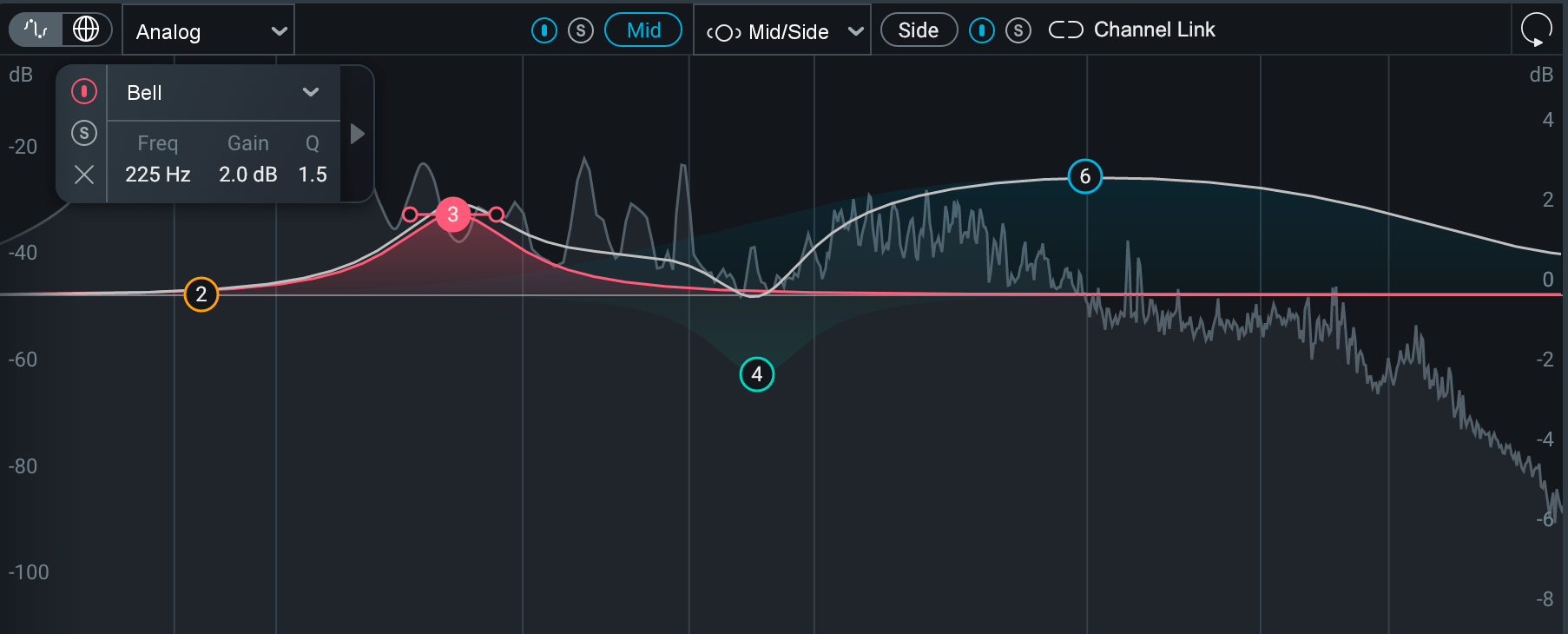
All Bands View
When selected, band controls are displayed in a table format below the spectrum. The HUD panel is not displayed when nodes are selected in All Bands View.
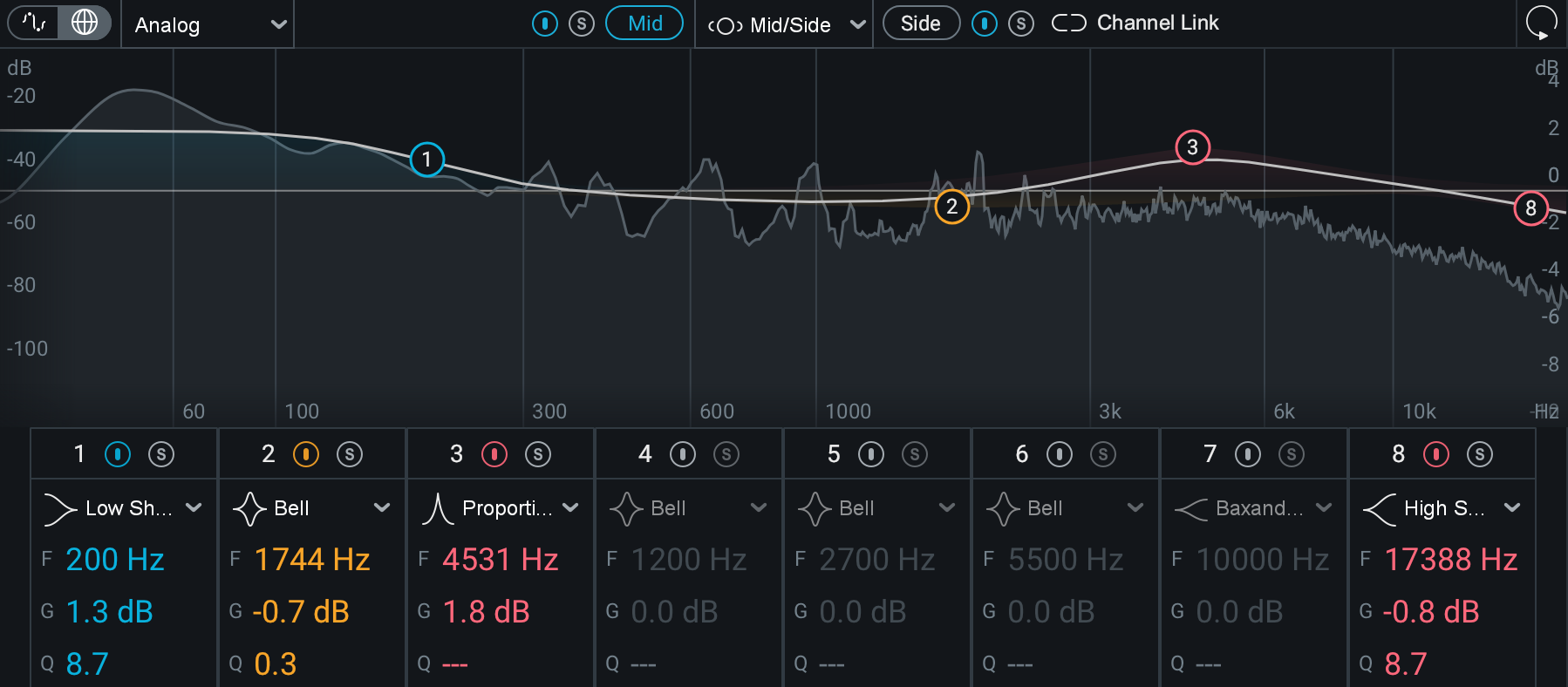
Channel Processing Modes
The channel processing mode determines how processing is applied by the Equalizer.

The following options are available in the dropdown menu:
- Stereo: Default mode. When selected, only one set of controls will be exposed and adjustments will apply to both channels.
- Mid/Side: Applies Mid/Side encoding to the signal coming into the module, allowing you to process the Mid and Side channels independently. One set of parameters applies processing to the encoded Mid channel and the second set of parameters applies processing to the encoded Side channel. The signal is decoded to a stereo signal at the output of the module.
- Left/Right: Allows you to process the Left and Right channels independently by splitting the module input signal into two processing channels. The signal is then ‘summed’ back to Stereo at the output of the module. One set of parameters applies processing to the Left channel and the second set of parameters applies processing to the Right channel.
Channel Processing Mode Controls
When Mid/Side or Left/Right mode is selected, the following controls become available in the module header area:

- Power Button: Enables/disables processing in the associated channel.
- Solo: Isolates the output of the associated channel.
- Channel selection buttons: Select the associated channel view by clicking the “Mid” or “Side” buttons (in Mid/Side mode) and the “Left” or “Right” buttons (in Left/Right mode).
- Channel Link: Enables/disables linked parameter adjustments on both channels.
Spectrum and EQ Curve
The main spectrum view of the Equalizer includes the following features:
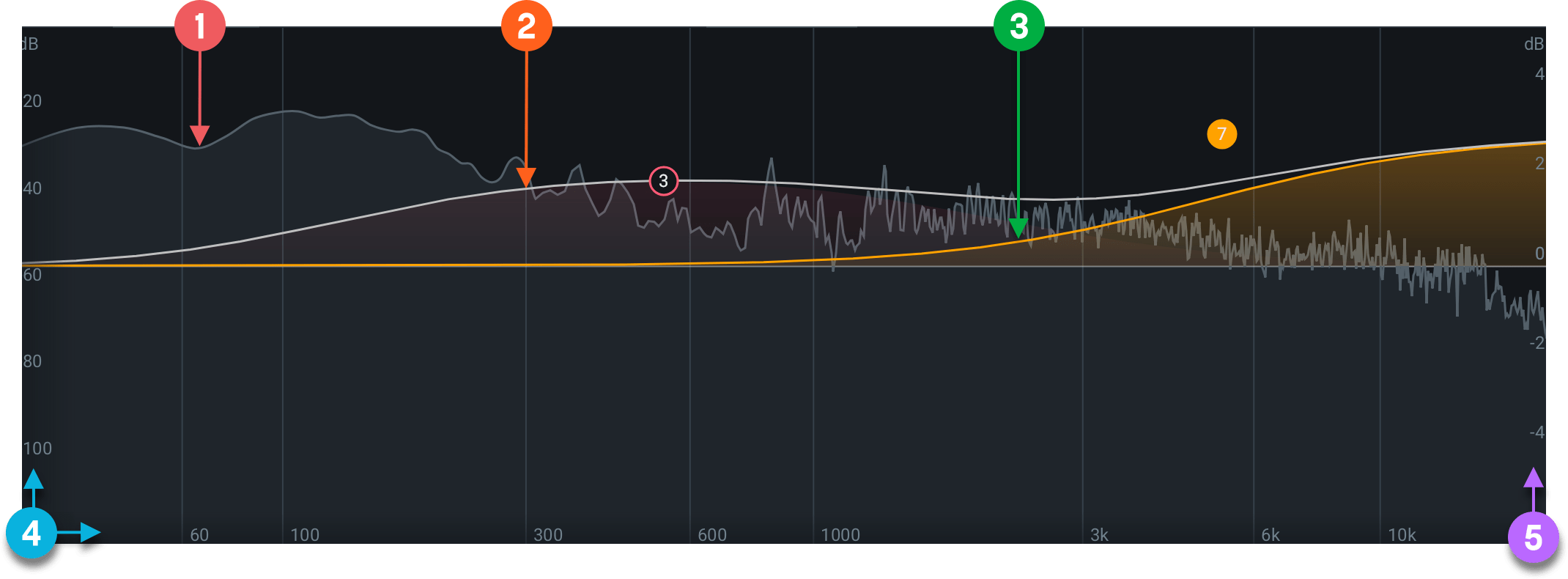
- Spectrum Analyzer: Displays the magnitude (amplitude, in decibels) of a signal across the frequency spectrum in real-time. The spectrum analyzer in the Equalizer module displays the output signal of Ozone.
- Composite curve: The combined filter response of all enabled bands. Represented by a thick white line drawn across the spectrum. Each band contributes to the overall shape of this curve.
- Filter response curve: The filter response of the currently selected node. Represented by a highlighted line and filled area under the band which appears when you select a node. If there are no nodes selected, the filter response curve is hidden and you will only see the composite curve.
- Spectrum Scales:
- Spectrum Magnitude Scale: (dB) Vertical scale displayed on the left side of the spectrum view.
- Spectrum Frequency Scale: (Hz) Horizontal scale displayed along the bottom of the spectrum view.
- Equalizer Gain Scale: (dB) The filter gain scale is located on the right side of the spectrum view. Range: +15 dB to -30 dB.
Spectrum scales
- The scales for the filter gain and the spectrum magnitude are different, by design. If they were made to match, you wouldn’t see enough of the spectrum for it to be useful.
- See the Options chapter for more information about spectrum scale options.
Extra Curves
When the Show Extra Curves option is enabled in the EQ options tab, three additional rulers appear on the right-hand side of the spectrum analyzer: Phase Response (degrees), Phase Delay (ms), Group Delay (ms).
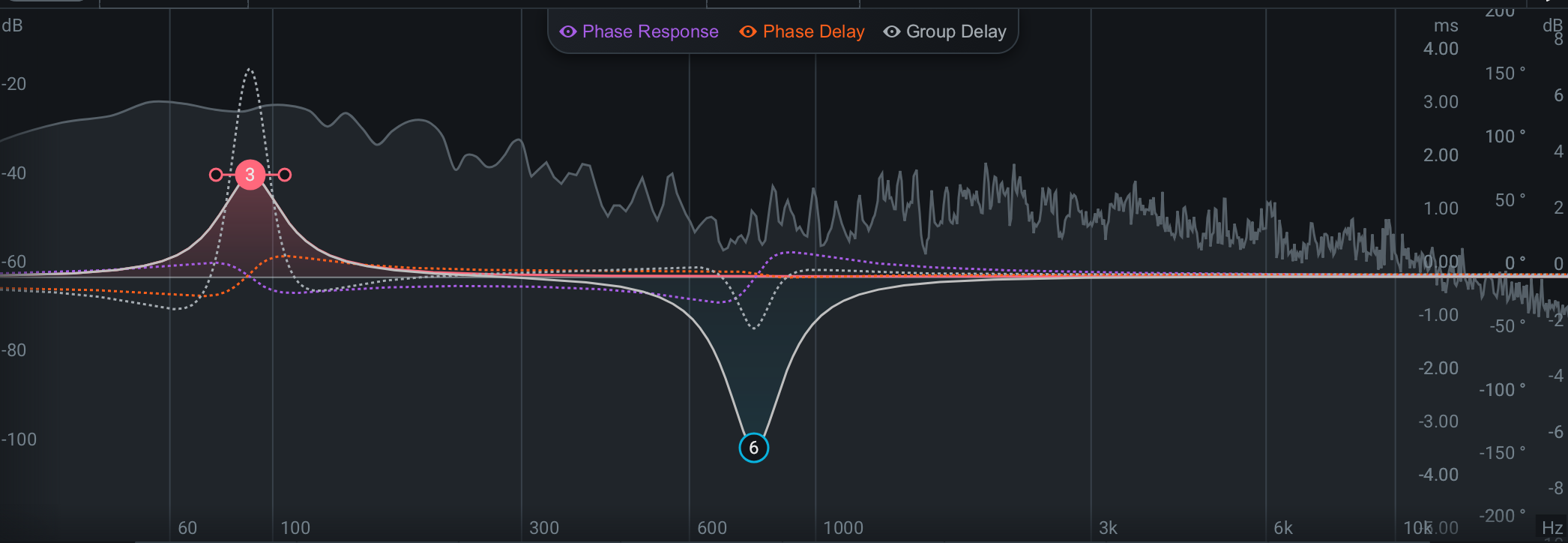
You can hide and show each curve individually by clicking on the buttons that appear in the legend along the top of the spectrum view.

- Phase Delay: A calculation of phase response represented in time (ms).
- Phase Response: A calculation of phase response represented in degrees. This curve is most useful when using analog or minimum phase equalization.
- Group Delay: A calculation of the delay of amplitude envelopes in time (ms). This curve is most useful when working with transients.
Alt-Solo
You can use the alt/option key when clicking on a node or anywhere in the spectrum to momentarily solo a specific frequency region. When you release the mouse click, alt-solo will be disabled.
- Band Solo: Hold the alt or option key and click on an EQ node. This is equivalent to pressing the Solo button in the HUD.
- Alt-Solo in Spectrum: Hold the alt or option key and click anywhere on the frequency spectrum to solo frequencies surrounding the location of the cursor. You can adjust the bandwidth of the alt-solo filter in the Options window.
Working with EQ Nodes
The following sections describe how to add, adjust and remove EQ nodes.
Adding Nodes
- Hover your cursor over the composite curve, click the + button that appears to add a new band to that frequency position.
- Press command+ return (Mac) or ctrl+ return (Windows) to add a new node to the center of the frequency spectrum.
- Double-click anywhere in the spectrum to add a new node at the frequency location of your cursor.
Default Filter Shape Assignment Based on Frequency
Default filter shapes are assigned to nodes depending on their initial frequency value.
- From 20 Hz to 100 Hz: Baxandall Bass. If a Baxandall Bass filter already exists in the curve, the default filter shape will be Proportional Q.
- From 100 Hz to 8 kHz: Proportional Q.
- From 8 kHz to 20 kHz: Baxandall Treble. If a Baxandall Treble filter already exists in the curve, the default filter shape will be Proportional Q.
Adjusting Nodes
The following methods can be used to move/adjust filter nodes:
- Click and drag a node up and down to adjust gain. Click and drag a node left and right to adjust frequency.
- Hold the shift key while clicking and dragging a node to lock the movement to the horizontal axis (for frequency) or vertical axis (for gain).
- Click and drag the handles that appear on the left/right side of a selected node to adjust the Q/Slope value.
- Press the up/down arrow keys to adjust the gain of a selected node. Press the left/right arrow keys to adjust the frequency of a selected node.
- Hold shift while using the arrow keys to make coarse value adjustments.
- Hold command (Mac) or ctrl (Windows) while using the arrow keys to make fine value adjustments.
- Double-click on a node to reset all band parameters to their default values.
Removing Nodes
The following methods can be used to remove filter nodes:
- In the HUD view: Select a node and click the X button in the HUD to remove it.
- In All Bands View: Click the power button associated with the band you want to remove in the controls section.
- Click & drag to select multiple nodes. Press delete or backspace key to remove all selected nodes.
- Hold Shift and click on individual nodes to select multiple nodes. Use the delete or backspace key to remove all selected nodes.
Controls
The following sections detail the EQ filter controls in the context of the HUD View. Any All Bands View differences or exceptions are noted in the control descriptions below.
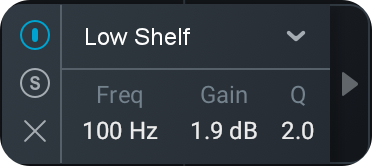
The HUD panel is divided into the folowing sections:
- General Controls: Enable/disable, Solo, and Remove.
- Filter Controls: Filter Shape, Frequency, Gain, and Q/Slope.
- Advanced Panel: Phase. Digital Mode only.
General Controls
You can enable/disable, solo, or remove a band with the buttons along the left edge of the HUD.
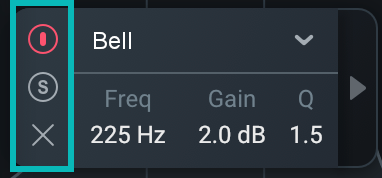
- Power: Click the power button to enable or disable processing for the selected band.
Power button behavior in All Bands View
When All Bands View is selected, clicking on a band power button will remove the associated band, rather than disable it.
- Solo: Click the S button to isolate playback of the selected band.
- Remove: Click the X button to remove the associated band.
Filter Controls
You can adjust filter shape, frequency, gain, and Q/bandwidth in this section of the HUD.
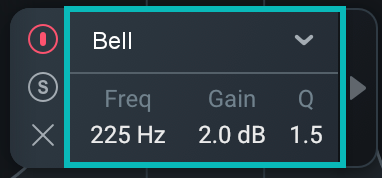
Filter Shape
Selects the filter shape for the associated band. The filter shapes are organized into sub-menus based on filter type and usage.
- BELL menu: These filters can be used to boost or cut a specific center frequency level (Peak type
filters). The following filter shapes are included in this menu:
- Bell: Smoothly boosts or cuts an adjustable region around a specific frequency.
- Proportional Q: Unique filter that varies shape in proportion to the amount of boost or cut applied. As a cut or boost is increased further away from center of the EQ curve, the shape tightens for more precision.
- Band Shelf: Bell filter with wide, flat top. Useful for boosting or attenuating a block of frequencies.
- LOW SHELF and HIGH SHELF menus: These filters can be used to boost or cut the frequency content above or
below a specified frequency (Shelf type filters). The following filter shapes are included in the
sub-menu:
- Analog: Efficient shelf filter for simple boosts and cuts.
- Baxandall: Gentle shelf filters. Modeled after the Baxandall EQ, with the addition of adjustable frequency.
- Vintage: Inspired by the renowned Pultec analog equalizer. Exhibits a complementary frequency dip, creating a complex slope with one node.
- Resonant: Exhibits a complimentary resonance at both ends of the filter slope creating a complex shape with one node.
- LOWPASS and HIGHPASS menus: These filters can be used to attenuate frequency content that is below (for
highpass) or above (for lowpass) a specified cutoff frequency (Pass type filters). The following filter
shapes are included in this sub-menu:
- Flat: Butterworth filter; optimized for maximum flatness without ripple or resonance in the passband or stopband (stability).
- Resonant: Filter equipped with a resonance control to emphasize the cutoff frequency with positive gain. Boosts content at the cutoff frequency to add character and emphasize the lowest or highest part of the signal.
- Brickwall: Elliptic filters. Optimized for steepness with minimal ripple in the passband and stopband.
- SURGICAL: (Digital mode only) Precise digital filter shape available in all filter shape sub-menus when Digital Filter Mode is selected in the module header.
Frequency
Determines the center or cutoff frequency of the selected band. Units: Hz (Hertz); Range: 20 Hz to 20 kHz.
Gain
Determines the amount of gain applied to the selected filter. Units: dB (decibels); Range: -30 dB to +15 dB.
Q/Slope
- Q: Determines the bandwidth (cF) of the selected filter.
- Slope: Determines the Slope of the filter below or above the set cutoff frequency. Slope is measured
in decibels per octave (dB/oct).
Fixed Q/Slope
The Baxandall Bass, Baxandall Treble, HP Brickwall and LP Brickwall filter shapes do not have adjustable Q/Slope values.
Advanced Controls
You can access the Advanced panel by clicking the arrow button on the right hand side of the HUD. If the Global Filter Mode is set to Analog, the Advanced panel button will be disabled. You can only access the Advanced panel of the HUD when the Global Filter Mode is set to Digital.

Phase
Adjusts the phase response of the currently selected filter.
- 0% Phase: the selected band will have a Linear phase response.
- 100% Phase: the selected band will have a Minimum phase response.
Phase Control Availability
- Phase is only adjustable when Digital Global Filter Mode is selected.
- Phase is not included in the controls table of the All Bands View. You can only access Phase from the Advanced panel of the HUD.
Imager
Table of Contents
Overview
The Imager allows you to adjust the stereo width of your mix. The Imager module interface is divided into four main sections:
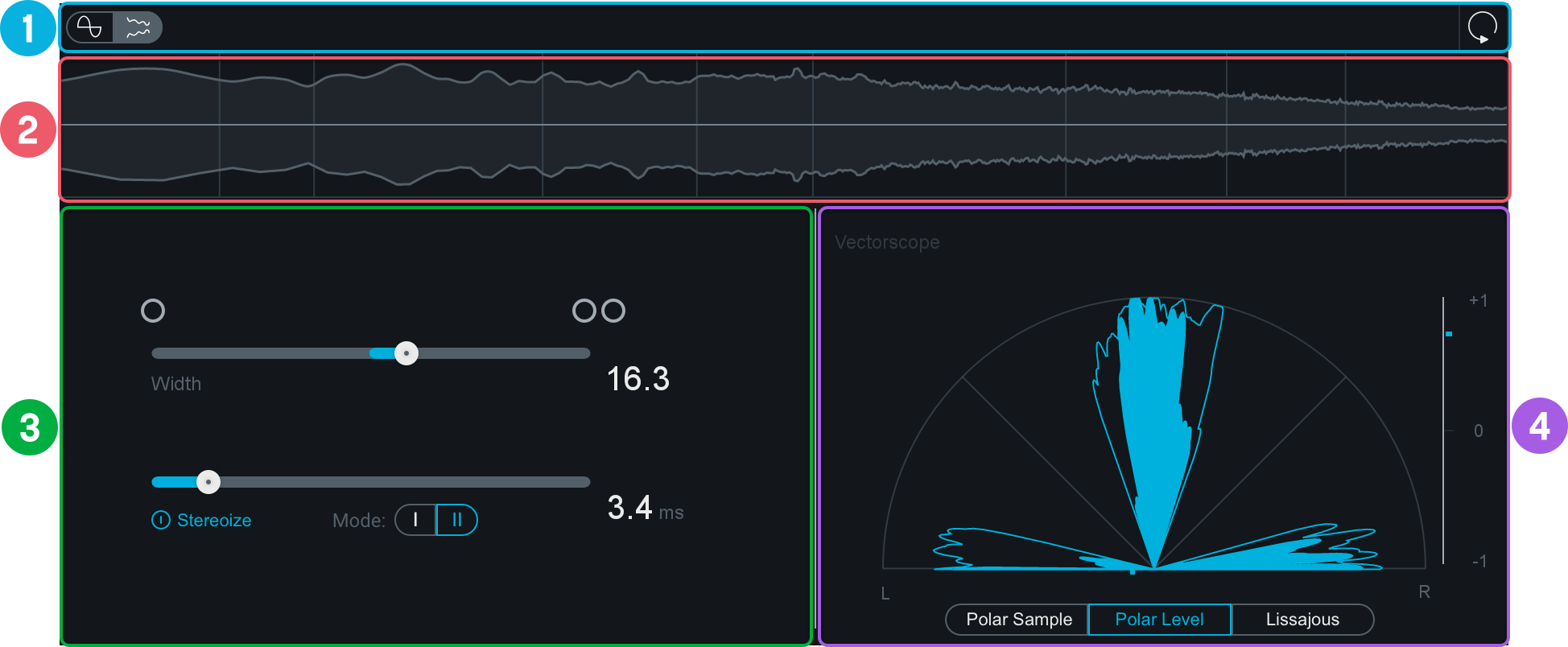
Module Header
The Imager module header includes the following controls:

- View Selector: See the Views section below for detailed descriptions of the different meter views.
- Reset: Returns all module controls to their default values.
Views
You can toggle between the different Imager views using the view selector buttons in the module header area.

The Imager module includes the following views:
Correlation Trace
Draws stereo correlation values over time. Negative correlation (out of phase) values are drawn in red; positive correlation (in phase) values are drawn in white.

The correlation trace displays information based on the output signal of Ozone, so adjustments to the Imager controls are reflected in this meter.
Stereo Width Spectrum
Displays a hybrid mirrored spectrum analyzer of the signal’s stereo width.

When the signal is fully mono, only a straight line will be drawn in the center of this view.
Controls
The Imager module includes the following controls:
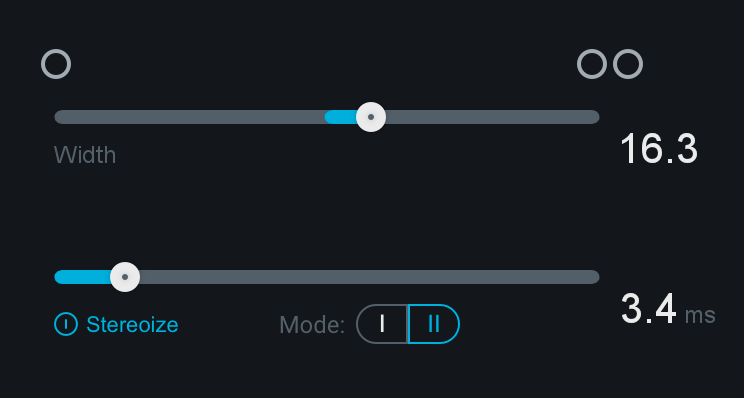
Width
Adjusts the amount of gain applied to side channel content. Positive values will increase perceived stereo width, and negative values will decrease the perceived stereo width of the signal. A setting of -100 will make the output signal effectively mono.
Note
If the input signal to the Imager is either: mono (i.e. single channel) or effectively mono (i.e. a stereo file with the same content on both channels), you will need to enable the Stereoize feature for Width adjustments to have an effect on the signal.
Stereoize
The following controls allow you to enable the stereoize effect and adjust the associated settings.
- Stereoize power button: Enables/disables stereoize processing.
- Stereoize Amount: Adjust the slider to add natural-sounding stereo width to narrow recordings and to
control the character of the stereo effect in conjunction with the width sliders.
Stereoize is Mono Compatible
The Stereoize effect is completely mono compatible. Even if you add width to audio, it can still be played back in mono without producing unpleasant artifacts.
- Stereoize Modes: There are two different stereoize processing modes available in the Imager:
- Mode I: Haas Effect-based decorrelation processing. This mode creates a delayed copy of the mid channel signal and injects it into the side channel.
- Mode II: A newly developed alternative to the classic stereoize mode. This new mode has a slightly different tonal quality from the original and helps to preserve transients at higher settings.
Vectorscope
The vectorscope meters provide a view of the stereo image of the signal after all other processing is applied in the signal chain.
Polar Sample
Plots dots per sample on a polar coordinate display to highlight the stereo image of the incoming signal.
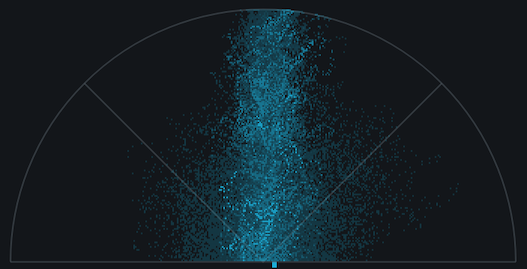
Patterns that appear within the 45-degree safe lines represent in-phase audio. Patterns outside these lines represent out-of-phase audio. The history of the Polar Sample Vectorscope fades out slowly. You can reset the display by clicking on the meter.
Polar Level
Plots rays on a polar coordinate display that represent sample averages and displays the stereo energy of a recording.

The length of the rays represents amplitude. The angle of the rays represents their position in the stereo image. Rays within the 45-degree safe lines represent in-phase audio. Rays beyond the safe lines represents out-of-phase audio.
Lissajous
Plots per-sample dots on a traditional oscilloscope display similar to the Polar Sample vectorscope.
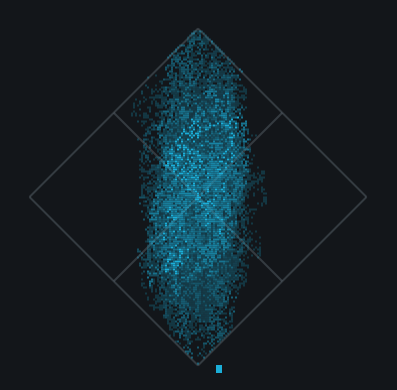
Typically, stereo recordings produce a random pattern on a Lissajous Vectorscope that is taller than it is wide. Vertical patterns mean left and right channels are similar (approaching mono). Horizontal patterns mean the two channels are very different, which could result in mono compatibility problems.
Clipping in the Vectorscope
Clipped samples are drawn in red along the edges of the vectorscope meter frame. Click on the meter to reset the clipped samples display.
Correlation Meter Bar
The vertical bar meter to the right of the vectorscope indicates the degree of similarity (or correlation) between the left and right channels.
Tips
- If the left and right channels are exactly the same, the correlation value would be +1 and the meter tick would be drawn at the top.
- If the left and right channels are exactly out-of-phase the correlation would be -1 and the meter tick would be drawn all the way at the bottom.
- In general, most recordings have phase correlations in the 0 to +1 range. A brief readout towards the bottom half of the meter is not necessarily a problem but could represent a possible mono compatibility issue.
- As you increase stereo widening, the phase correlation will tend to draw more towards the bottom half of the meter, as the left and right channels will become “wider” and less similar.
Stereo Balance Meter
The horizontal bar meter directly below the vectorscope meter indicates the stereo balance of the signal. When the meter tick is drawn all the way to the left, it indicates there is only information on the left channel. When the meter tick is drawn all the way to the right, it indicates that there is only information on the right channel.
Maximizer
Table of Contents
Overview
Ozone’s acclaimed IRC (Intelligent Release Control) technology lets you boost the overall level of your mixes without sacrificing dynamics or clarity.
The module interface includes the following main sections:

Module Header
The module header area includes the following controls:

- View Selector: See the Views section below for detailed descriptions of the different meter views.
- Learn Threshold: When enabled, the Maximizer will listen to your track and adjust the
Threshold so that the output loudness matches the Target LUFS value. Learn Threshold will
continue to update based on your track input until it is manually disabled.
Not Recommended for Loudness Compliance
Learn Threshold should not be used to meet loudness compliance standards.
- Target LUFS: Sets the loudness target (in LUFS) that the Maximizer will use when calculating the optimal Threshold for your track.
- Reset: Returns all module controls to their default values.
Views
You can toggle between the different views using the view selector buttons in the module header area.

The Maximizer module includes the following views:
Spectrum Analyzer
Displays the magnitude (amplitude, in decibels) of a signal across the frequency spectrum in real-time. The spectrum analyzer displays the output signal of Ozone.

Gain Reduction Trace
Displays a scrolling waveform with a superimposed trace reflecting the amount of gain reduction applied over time.

Controls
The Maximizer includes the following controls:

Mode
The Maximizer includes the following Intelligent Release Control (IRC) modes:
- IRC I: Provides intelligent digital loudness maximization of the signal. It does this by analyzing the source material and applying limiting in a psychoacoustically pleasing manner, reacting quickly to transients (to prevent pumping) and reacting more slowly to steady bass tones (to prevent distortion).
- IRC II: Similar to IRC I, but optimized to preserve transients even more, so they sound sharper and clearer in the output signal, even when aggressive limiting is taking place.
Threshold
Set the level at which the limiter will be triggered and adjusts the amount of gain added to the signal to maximize the output level.
Threshold and Maximizer Output
Setting the Threshold to a non-zero value that doesn’t trigger the limiter will still increase the output of the Maximizer. For example if the input level to the Maximizer is peaking at -15 dB and the Maximizer Threshold is set to -4dB, limiting will not occur, but the level at the output of the Maximizer will be peaking at -11dB.
The threshold control includes the following sub-controls and meter:
Threshold Meter
Displays input level and applied gain reduction.

- The two outer meters display input level to the limiter.
- The two inner meters display gain reduction applied by the limiter.
- The text readout at the bottom of the meter displays the current gain reduction amount that is being applied by the limiter.
Ceiling
Adjust to set the maximum output level of the Maximizer.
Threshold and Ceiling Link
Enable to link the Threshold and Ceiling controls. Adjusting either control in linked mode will adjust the other control by the same amount and vice versa.
True Peak
When enabled, the limiter will account for the levels of each digital sample and the levels of the analog signal that will eventually be produced by D/A conversion. This is sometimes necessary, since an analog signal’s peak level can exceed the corresponding digital signal’s peak level by more than 3 dB.
True Peak Limiting & CPU Usage
This option will result in a small increase in CPU usage, but if your mixes are running very hot you may want to enable it to ensure that absolutely no distortion is introduced when your audio is finally run through a D/A converter.
Character
Adjust to customize the overall response time (attack and release times) of the Maximizer. The attack and release times are influenced by the selected Mode. The Character slider ranges from Fast (0.0) to Slow (10.0) in each mode.
Stereo Independence
The Stereo Independence controls represent the next iteration of the Stereo Unlink control in previous versions of Ozone. By default, the Stereo Independence controls (Transient and Sustain) will be linked and set to 0% - mimicking the default settings of the previous Stereo Unlink control.
- Transient Slider: Adjusts how the limiter responds to transient material across channels.
- Sustain Slider: Adjusts how the limiter responds to sustained material across channels.
- Link: Links the Transient and Sustain sliders.
Examples
- Both Sliders set to 100%: It is possible to achieve a louder output from the Maximizer, but this can result in a narrow stereo image. To alleviate the narrowing effect of the Stereo Unlink control, we split this feature into two sliders.
- Sliders independently set to non-zero values: Applies limiting to transient and sustained material separately, based on a level envelope generated from a ratio of the individual channel levels and the entire stereo image.
Transient Emphasis
Enable Transient Emphasis adjustment by clicking the Transient Emphasis power button. Adjusting the Amount control allows you to fine-tune the shaping of transients before limiting takes place. This can be useful for preserving sharper sounds, like drums, while still optimizing loudness.
Transient Emphasis Settings
Using higher amount values for Transient Emphasis will result in more pronounced transients after the limiting process.
Presets
Table of Contents
Overview
The presets included with Ozone Elements are designed to give you a quick starting point for mastering your projects. You can load, save, or customize presets with the preset manager. There are two types of preset manager windows in Ozone Elements:
- Global Preset Manager: Click on the preset name display bar in the header to open the global preset manager window.
- Module Preset Manager: Click on the Presets button in a module’s signal chain tile to open the associated module preset manager window.
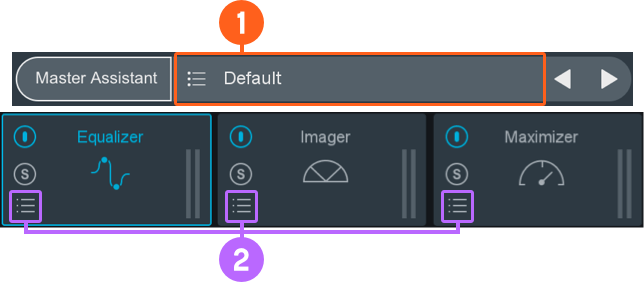
Factory and Custom Presets
The preset manager windows are divided into two tabs:

- iZotope: lists all factory presets installed with Ozone 9 Elements.
- Custom: lists all custom presets you have saved or modified in Ozone 9 Elements.
Default and Working Settings
There are two common options that are always available at the top of the preset list in the iZotope and Custom tabs, named Working Settings and Default.

- Working Settings: Loads your most recent changes that are not otherwise associated with a preset.
- Default: Loads the factory default settings.
Custom Default Preset
You can override the factory <Default> preset by selecting any preset as your custom default.
Setting a Custom Default Preset
- Right-click on the preset that you want to use as your default.
- Select
Set <SelectedPresetName> as Defaultin the right-click context menu. - After setting your custom default preset, selecting
<Default>in the preset manager window will load your custom default settings. New instances of Ozone will also use your custom default settings.
Reverting a Custom Default Preset
You can revert to the factory default preset by:
- Open the preset manager.
- Right-click on any preset in the list.
- Select
Reset Default to factory defaultfrom the right-click context menu.
Custom Preset Names and Comments
You can modify preset file/folder names and preset comments when the Custom tab is selected.
- Edit custom preset name: Double-click on a preset name to open an inline edit field. Press return to dismiss the inline edit field and save your changes.
- Edit custom preset comment: The area below the preset list displays descriptive text about the currently selected preset. Single-click the comment text box to open an inline edit field, press return to save changes to the comment.
Special characters in Preset Names
Some characters such as * or / cannot be used as preset names. If you try to type these characters in the
name they will be ignored.
Preset Manager Footer
The following buttons are located in the footer of the Preset Manager window:

- Delete: Deletes the currently selected custom preset or preset folder.
- Update: Saves changes to a modified custom preset. Note: Update is only available in the global preset manager, you cannot update module presets.
- Folder: Adds a new custom preset folder.
- New: Creates a new preset based on the current settings.
- Close: Dismiss the Preset Manager window.
Dirty state indicator
When you make changes to a preset an asterisk (*) will be shown at the beginning of the preset name to indicate that it has been modified. You can add a new preset to save your settings or update the preset to dismiss the dirty state indicator.
Organize Custom Presets
In the Custom tab, you can click and drag presets or folders over other folders in the list to move them into that folder.
Preset Locations
Factory presets are installed to the following locations:
- Windows:
C:\Program Files\iZotope\Ozone 9 Elements\Presets\ - Mac:
/Library/Application Support/iZotope/Ozone 9 Elements/Presets/
Custom presets are saved to the following default locations:
- Windows:
C:\Users\Username\Documents\iZotope\Ozone 9 Elements\Presets\ - Mac:
/Users/Username/Documents/iZotope/Ozone 9 Elements/Presets/
Override custom preset save locations
A ... button will appear in the upper left hand corner of the preset window when the Custom tab is
selected.
Click the button to open a system dialog and select a new directory to save your custom presets to.
The custom path for global and per module presets are set individually in their respective preset manager windows.
Options
Table of Contents
Overview
You can adjust global and module-specific settings in the Options window. You can open the Options window by clicking the gear button in the upper right hand corner of the Ozone interface.

You can access different groups of options by clicking on a tab in the upper portion of the Options window. You can reset, save or cancel changes to options using the buttons in the footer area of the options window.
Options Window Footer Controls
The bottom of the options window includes the following global parameters:

- ?: Opens the Ozone help documentation in your default web browser.
- Reset: Resets all Options in the currently selected options tab to their factory default values.
- Version information: Displays the current Ozone version and build number.
- Cancel: Closes the Options window without saving changes.
- Ok: Closes the Options window and saves changes.
General Options
The General Options tab allows you to adjust settings related to graphics, authorization, updates, usage tracking and undo history.

General: Graphics
- Show Tooltips: Enables the display of a descriptive text box when hovering your cursor over a control.
- Dim Controls When Bypassed: Enables an overlay that dims the appearance of controls in the module control panel when Ozone is bypassed.
- Window Opacity: Adjusts the transparency of the plug-in interface.
General: License & Updates
- Check for Updates: The Check for Updates button has the following states:
- Download Product Portal: To stay up to date with the latest version of Ozone Elements, download the iZotope Product Portal application.
- Check for Updates: Manually check for available updates. Clicking this button will open the Product Portal application and check for updates.
- Download Update: If an update is available, a small blue dot will appear. Clicking the Download Update button in the options window will launch the Product Portal application and display the Updates page.
- License: Displays the current authorization state.
- Authorize: Opens the iZotope Authorization wizard.
- Remove Authorization: Removes the current authorization.
General: Other
- Enable Analytics: Enables anonymous usage data to be sent to iZotope to help improve Ozone in the future.
- History Depth: Determines the number of parameter change events to store in the Undo History list.
- Keyboard support: Determines the level of keyboard shortcut support given to Ozone. Options include: None, Minimal (Tab, Enter and arrow keys only), or Full. If you are running into conflicts with your DAWs keyboard shortcuts when the plug-in window is in focus, try setting this option to None or Minimal.
Spectrum Options
The Spectrum options tab allows you to manage options related to the Spectrum view in all Ozone modules.
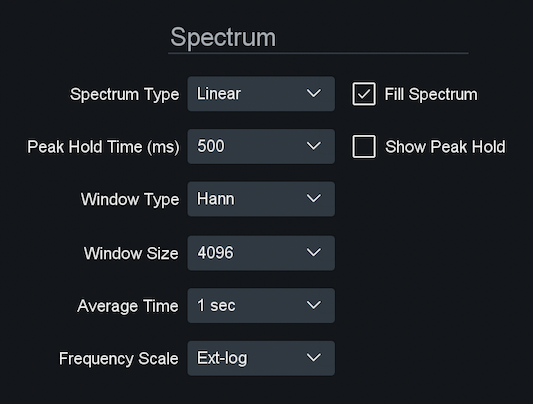
- Type: Selects the type of spectrum display used by spectrum analyzer views in all Ozone modules. The
following options are available:
- Linear: A continuous line connecting the calculated points of the spectrum.
- 1/3 Octave: Splits the spectrum into bars with a width of 1/3 of an octave. Although the spectrum is split into discrete bands, this option can provide excellent resolution at lower frequencies.
- Critical: Splits the spectrum into bands that correspond to how we hear, or more specifically how we differentiate between sounds of different frequencies. Each band represents sounds that are considered “similar” in frequency.
- Full Octave: Splits the spectrum into bars with a width of one full octave.
- Fill Spectrum: Allows you to display the real-time spectrum as a solid graph as opposed to a line graph. This option can be used to differentiate the real-time spectrum from the peak hold spectrum.
- Peak Hold Time (ms): Sets the length of time the peak hold display will hold before updating. You can choose between specific hold times (in milliseconds) or Infinite, where the peak display is held indefinitely.
- Show Peak Hold: Toggles whether Ozone displays and holds the peaks of the spectrum.
- Window Type: Sets the window type for the spectrum. In most cases the default window type will work well, but you can choose from a variety of window types. Each window type has different amplitude and frequency resolution characteristics.
- Window Size: Controls the tradeoff between time and frequency resolution in the spectrum analyzer. Higher values offer greater frequency resolution.
- Average Time: Averages the spectrum according to this setting. Higher average times can be useful for viewing the overall tonal balance of a mix, while shorter average times provide a more real-time display. Options include: Real Time, 1 sec, 3 sec, 5 sec, 10 sec, and Infinite.
- Frequency Scale: Modifies the distribution of frequencies along the frequency axis of the spectrum
analyzer. The default frequency scale is Extended Log.
- Mel: Displays a frequency scale based on human perception of sound that visually corresponds to how we hear differences in pitch.
- Logarithmic (Flat, Extended) Logarithmic: Displays non-linear scales that offer detail on the low end and midrange, useful for the vast majority of EQ tasks.
EQ Options
The EQ tab includes EQ Spectrum and Performance options.
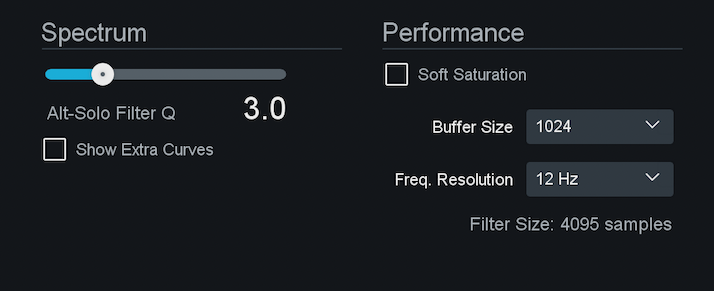
EQ: Spectrum
- Alt-Solo Filter Q: Sets the bandwidth (Q) of the Alt-Solo feature in the Equalizer module(s).
- Show Extra Curves: Toggles the display of Phase Delay, Phase Response, and Group Delay curves in the EQ spectrum.
EQ: Performance
- Soft Saturation: Select to enable soft saturation to in the EQ module. When enabled, signals that clip as a result of being boosted by the EQ will saturate with an analog character, rather than harsh digital clipping.
- Buffer Size: Select to adjusts the memory buffer size, measured in samples, when applying equalization to the signal.
- Frequency Resolution: Select to set the minimum resolution, in Hz, the Equalizer can be adjusted by. You can choose from: 3 Hz, 6 Hz, 12 Hz, 24 Hz, and 48 Hz.
- Filter Size: Displays the calculated steepness of the filter setting used in the EQ module.
Imager Options
This tab includes options related to metering and processing in the Imager module.
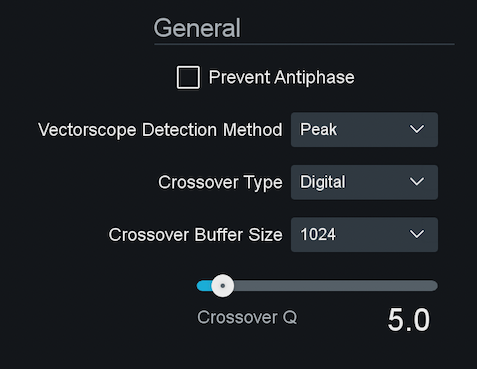
- Prevent Antiphase: Select to automatically prevent any settings from being applied that would result in phase cancellation of the stereo signal, when summed to mono.
- Vectorscope Detection Method: Determines the type of amplitude detection method used by the Vectorscope.
- Peak: Uses the peak level of the incoming signal.
- RMS: Uses the average level of the incoming signal.
- Envelope: Similar to RMS, uses average level of the incoming signal evened out across all frequencies.
I/O Options
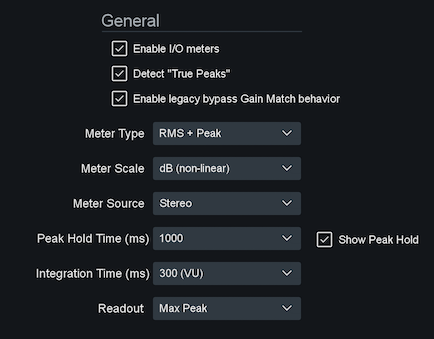
-
Enable I/O meters: Select to enable/disable the meters in Ozone’s master I/O section.
-
Detect true peaks: Select Detect True Peaks to accurately measure the signal that will result from digital to analog conversion. By default the Input/Output meters will only indicate clipping which occurs within the digital domain.
-
Enable legacy bypass gain match behavior: Determines the behavior of the Gain Match feature in the I/O auditioning section.
- Behavior when checked: Gain matching is applied to the bypassed output of Ozone and does not affect the I/O gain. The bypassed output level will be adjusted by the amount of gain introduced by Ozone processing. This allows you to A/B your processing without noticeable jumps in level between the bypassed and unbypassed signals. This gain adjustment is only applied to the output signal when Ozone is bypassed and Gain Match is enabled in the I/O auditioning section.
- Behavior when unchecked: Gain matching is applied to the processed output of Ozone. Ozone’s output gain will be automatically adjusted to match the unprocessed input level. The output level sliders will be colored blue when this gain matching is active. Unlike the legacy auto gain match behavior, we recommend turning Gain Match on and off as needed rather than keeping it enabled all the time. This behavior does affect the output level of Ozone.
-
Meter Type: Choose from one of the following options to set the meter type displayed in the I/O meters:
- RMS: RMS (Root Mean Square) is a software-based implementation of an analog-style level meter. Using different integration times, you can model popular VU or PPM meters. The RMS meter displays the average level calculated over a short window of time. The RMS meter readout will typically be lower than an equivalent PPM meter (Digital/Analog), since it is averaging peaks into the overall loudness.
- PEAK: The Peak meter is a fast meter that measures instantaneous maximum sample value or peak analog waveform values, depending on the “detect inter-sample peaks” checkbox. If you are tracking the peaks for possible clipping, the Peak meter is appropriate.
- RMS + PEAK: This is a combined RMS and Peak meter. This meter displays a lower bright bar representing the average level (RMS) and a higher dimmer bar representing peak level. There is also a moving line above the bar representing the most recent peak level or peak hold.
- K-SYSTEM: Ozone 9 supports Bob Katz’s K-System metering with simultaneous peak and RMS displays.
- MOMENTARY: This measurement is a calculation of loudness over the course of 400ms.
- SHORT TERM: This measurement is a calculation of loudness over the course of 3 seconds.
- INTEGRATED: This measurement is a calculation of loudness over the course of an indefinite period of time.
-
Meter Scale: Choose from one of the following options to set the range and scale of the I/O Meters:
- dB (Linear): Decibel scale presented linearly from -60 dB to 0.
- dB (Non-linear): Full decibel scale (dBfs) presented non-linearly.
- BS.1771: Loudness scale recommended by the ITU that spans from -45 LUFS to -14.0 LUFS.
- EBU +9: Loudness scale recommended as a default by the EBU that spans from -41.0 LUFS to -14.0 LUFS.
- EBU +18: Loudness scale recommended for material with a wide Loudness Range by the EBU that spans from
-59.0 LUFS to -5.0 LUFS.
LUFS
LUFS is Loudness Units Full Scale and 1 LUFS = 1 dB.
-
Meter Source: The following meter source options are available: Stereo and Mid/Side. The I/O meters display Stereo information by default. When the I/O meters are in Mid/Side mode, the meter in the center represents the Mid channel level information and the meters on the left and right represents Side channel level information.

Gain sliders control Left/Right gain in Mid/Side mode
The input and output gain sliders always control the left and right input/output gain, regardless of the Meter Source selection.
-
Peak Hold Time (ms): Choose from the following options to set how many consecutive samples of audio must exceed 0 dBFS (full scale) before registering as a peak: 5 ms, 250 ms, 500 ms, 1,000 ms, 5,000 ms, and Infinite.
-
Integration time (ms): Choose from the following options to specify the integration time for the RMS calculation: 10 ms, 50 ms, 300 ms (VU), 1,475 ms, 2,650 ms, 3,825 ms, and 5,000 ms. In most RMS meters, the integration time is set to around 300 ms.
-
Readout: Selects whether the peak hold section of the meters displays the current peak status (current) or instead displays the highest peak that has occurred in the audio file (max peak).
-
Show Peak Hold: Displays peak hold bars in the I/O meters.
Customer Care
Purchasing Ozone 9 Elements
If you are using the demo version of Ozone 9 Elements and would like the full version, you can purchase directly from the iZotope online store: www.izotope.com/store
Once your purchase is complete, you will be sent an email confirmation and a full version serial number that can be used to fully authorize your current installation of Ozone 9 Elements.
iZotope Customer Care policy
iZotope is happy to provide professional technical Customer Care to all registered users absolutely free of charge. www.izotope.com/support/contact/index.php
We also offer valuable pre-sales technical Customer Care to customers who may be interested in purchasing an iZotope product. Before contacting iZotope Customer Care, you can search our Product Knowledgebase to see if the solution to your problem has already been published.
How long does iZotope provide customer support for purchased products? You can email us with any question for 12 months after you buy any iZotope product. Past 12 months, we’ll still help you with your account and authorization but will not provide technical support for in-depth product questions. If you need more detailed help on how to use the product, please check out our FAQs and Tutorials.
How long does iZotope support its products? Although we can’t guarantee it, we do our best to keep our products up to date with the operating systems and plug-in hosts that we support. Sometimes, other companies make changes that we’re not able to support, but we actively work with other companies to avoid these sorts of compatibility problems. We also do our best to address bug fixes within the product itself to ensure our products operate in accordance with our specifications.
We will provide software updates for 12 months from product release. After 12 months, no software updates will be provided.
For details on what operating systems and plug-in host software are officially supported for a product, please check that product’s Specs page.
Contacting iZotope Customer Care
For additional help with Ozone 9 Elements:
- Check out the Customer Care pages on our web site at www.izotope.com/support
- Contact our Customer Care department at support@izotope.com
iZotope’s highly trained Customer Care team is committed to responding to all requests within one (1) business day and frequently respond faster. Please try to explain your problem with as much detail and clarity as possible. This will ensure our ability to solve your problem accurately, the first time around. Please include all system specs and the build/version of Ozone 9 that you are using.
Once your Customer Care request is submitted, you will receive a confirmation email from iZotope Customer Care. If you do not receive this email within a few minutes, please check your spam folder and make sure our responses are not getting blocked. To prevent this from happening please add support@izotope.com to your list of allowed email addresses.
International Distribution Customer Care is also available from our international distributors worldwide for any customers who purchased their iZotope products through a certified iZotope distributor.
Check with your local distributor for availability. If you would like help locating your local distributor please contact iZotope Customer Care.
Thanks for using Ozone 9 Elements!
-The iZotope Team
License Information
Table of Contents
- Anti-Grain Geometry
- Better Enums
- Bravura
- C++ Rest SDK
- Eigen
- FLAC
- FreeType
- GLEW
- gsl
- IcoMoon
- Intel® Integrated Performance Primitives (Intel® IPP)
- JsonCpp
- LAME
- LibXML2
- Material Docs Theme
- nanomsg
- Netlib numeralgo na10 Aberth’s method
- OGG / Vorbis
- readerwriterqueue
- Roboto font family
- Skia
- TagLib
- TinyXML
- Tipue Search
- vectorize
- xsimd
- Yoga
- ZeroMQ
- zlib
Anti-Grain Geometry
Version 2.4
Copyright (c) 2002-2005 Maxim Shemanarev (McSeem).
Redistribution and use in source and binary forms, with or without modification, are permitted provided that the following conditions are met:
-
Redistributions of source code must retain the above copyright notice, this list of conditions and the following disclaimer.
-
Redistributions in binary form must reproduce the above copyright notice, this list of conditions and the following disclaimer in the documentation and/or other materials provided with the distribution.
-
The name of the author may not be used to endorse or promote products derived from this software without specific prior written permission.
THIS SOFTWARE IS PROVIDED BY THE AUTHOR ‘‘AS IS’’ AND ANY EXPRESS OR IMPLIED WARRANTIES, INCLUDING, BUT NOT LIMITED TO, THE IMPLIED WARRANTIES OF MERCHANTABILITY AND FITNESS FOR A PARTICULAR PURPOSE ARE DISCLAIMED. IN NO EVENT SHALL THE AUTHOR BE LIABLE FOR ANY DIRECT, INDIRECT, INCIDENTAL, SPECIAL, EXEMPLARY, OR CONSEQUENTIAL DAMAGES (INCLUDING, BUT NOT LIMITED TO, PROCUREMENT OF SUBSTITUTE GOODS OR SERVICES; LOSS OF USE, DATA, OR PROFITS; OR BUSINESS INTERRUPTION) HOWEVER CAUSED AND ON ANY THEORY OF LIABILITY, WHETHER IN CONTRACT, STRICT LIABILITY, OR TORT (INCLUDING NEGLIGENCE OR OTHERWISE) ARISING IN ANY WAY OUT OF THE USE OF THIS SOFTWARE, EVEN IF ADVISED OF THE POSSIBILITY OF SUCH DAMAGE.
Better Enums
Version 0.11.1
Copyright (c) 2012-2016, Anton Bachin. All rights reserved.
Redistribution and use in source and binary forms, with or without modification, are permitted provided that the following conditions are met:
-
Redistributions of source code must retain the above copyright notice, this list of conditions and the following disclaimer.
-
Redistributions in binary form must reproduce the above copyright notice, this list of conditions and the following disclaimer in the documentation and/or other materials provided with the distribution.
THIS SOFTWARE IS PROVIDED BY THE COPYRIGHT HOLDERS AND CONTRIBUTORS “AS IS” AND ANY EXPRESS OR IMPLIED WARRANTIES, INCLUDING, BUT NOT LIMITED TO, THE IMPLIED WARRANTIES OF MERCHANTABILITY AND FITNESS FOR A PARTICULAR PURPOSE ARE DISCLAIMED. IN NO EVENT SHALL THE COPYRIGHT HOLDER OR CONTRIBUTORS BE LIABLE FOR ANY DIRECT, INDIRECT, INCIDENTAL, SPECIAL, EXEMPLARY, OR CONSEQUENTIAL DAMAGES (INCLUDING, BUT NOT LIMITED TO, PROCUREMENT OF SUBSTITUTE GOODS OR SERVICES; LOSS OF USE, DATA, OR PROFITS; OR BUSINESS INTERRUPTION) HOWEVER CAUSED AND ON ANY THEORY OF LIABILITY, WHETHER IN CONTRACT, STRICT LIABILITY, OR TORT (INCLUDING NEGLIGENCE OR OTHERWISE) ARISING IN ANY WAY OUT OF THE USE OF THIS SOFTWARE, EVEN IF ADVISED OF THE POSSIBILITY OF SUCH DAMAGE.
Bravura
Copyright © 2015, Steinberg Media Technologies GmbH http://www.steinberg.net/, with Reserved Font Name “Bravura”.
This Font Software is licensed under the SIL Open Font License, Version 1.1. This license is copied below, and is also available with a FAQ at: http://scripts.sil.org/OFL
SIL OPEN FONT LICENSE Version 1.1 - 26 February 2007
PREAMBLE
The goals of the Open Font License (OFL) are to stimulate worldwide development of collaborative font
projects, to support the font creation efforts of academic and linguistic communities, and to provide a free
and open framework in which fonts may be shared and improved in partnership with others.
The OFL allows the licensed fonts to be used, studied, modified and redistributed freely as long as they are not sold by themselves. The fonts, including any derivative works, can be bundled, embedded, redistributed and/or sold with any software provided that any reserved names are not used by derivative works. The fonts and derivatives, however, cannot be released under any other type of license. The requirement for fonts to remain under this license does not apply to any document created using the fonts or their derivatives.
DEFINITIONS
“Font Software” refers to the set of files released by the Copyright Holder(s) under this license and clearly
marked as such. This may include source files, build scripts and documentation.
“Reserved Font Name” refers to any names specified as such after the copyright statement(s).
“Original Version” refers to the collection of Font Software components as distributed by the Copyright Holder(s).
“Modified Version” refers to any derivative made by adding to, deleting, or substituting – in part or in whole – any of the components of the Original Version, by changing formats or by porting the Font Software to a new environment.
“Author” refers to any designer, engineer, programmer, technical writer or other person who contributed to the Font Software.
PERMISSION & CONDITIONS
Permission is hereby granted, free of charge, to any person obtaining a copy of the Font Software, to use,
study, copy, merge, embed, modify, redistribute, and sell modified and unmodified copies of the Font Software,
subject to the following conditions:
-
Neither the Font Software nor any of its individual components, in Original or Modified Versions, may be sold by itself.
-
Original or Modified Versions of the Font Software may be bundled, redistributed and/or sold with any software, provided that each copy contains the above copyright notice and this license. These can be included either as stand-alone text files, human-readable headers or in the appropriate machine-readable metadata fields within text or binary files as long as those fields can be easily viewed by the user.
-
No Modified Version of the Font Software may use the Reserved Font Name(s) unless explicit written permission is granted by the corresponding Copyright Holder. This restriction only applies to the primary font name as presented to the users.
-
The name(s) of the Copyright Holder(s) or the Author(s) of the Font Software shall not be used to promote, endorse or advertise any Modified Version, except to acknowledge the contribution(s) of the Copyright Holder(s) and the Author(s) or with their explicit written permission.
-
The Font Software, modified or unmodified, in part or in whole, must be distributed entirely under this license, and must not be distributed under any other license. The requirement for fonts to remain under this license does not apply to any document created using the Font Software.
TERMINATION
This license becomes null and void if any of the above conditions are not met.
DISCLAIMER
THE FONT SOFTWARE IS PROVIDED “AS IS”, WITHOUT WARRANTY OF ANY KIND, EXPRESS OR IMPLIED, INCLUDING BUT NOT
LIMITED TO ANY WARRANTIES OF MERCHANTABILITY, FITNESS FOR A PARTICULAR PURPOSE AND NONINFRINGEMENT OF
COPYRIGHT, PATENT, TRADEMARK, OR OTHER RIGHT. IN NO EVENT SHALL THE COPYRIGHT HOLDER BE LIABLE FOR ANY CLAIM,
DAMAGES OR OTHER LIABILITY, INCLUDING ANY GENERAL, SPECIAL, INDIRECT, INCIDENTAL, OR CONSEQUENTIAL DAMAGES,
WHETHER IN AN ACTION OF CONTRACT, TORT OR OTHERWISE, ARISING FROM, OUT OF THE USE OR INABILITY TO USE THE FONT
SOFTWARE OR FROM OTHER DEALINGS IN THE FONT SOFTWARE.
C++ Rest SDK
Version 2.10.15
Main Library:
Copyright (c) 2014, Peter Thorson. All rights reserved.
Redistribution and use in source and binary forms, with or without modification, are permitted provided that the following conditions are met:
-
Redistributions of source code must retain the above copyright notice, this list of conditions and the following disclaimer.
-
Redistributions in binary form must reproduce the above copyright notice, this list of conditions and the following disclaimer in the documentation and/or other materials provided with the distribution.
-
Neither the name of the WebSocket++ Project nor the names of its contributors may be used to endorse or promote products derived from this software without specific prior written permission.
THIS SOFTWARE IS PROVIDED BY THE COPYRIGHT HOLDERS AND CONTRIBUTORS “AS IS” AND ANY EXPRESS OR IMPLIED WARRANTIES, INCLUDING, BUT NOT LIMITED TO, THE IMPLIED WARRANTIES OF MERCHANTABILITY AND FITNESS FOR A PARTICULAR PURPOSE ARE DISCLAIMED. IN NO EVENT SHALL PETER THORSON BE LIABLE FOR ANY DIRECT, INDIRECT, INCIDENTAL, SPECIAL, EXEMPLARY, OR CONSEQUENTIAL DAMAGES (INCLUDING, BUT NOT LIMITED TO, PROCUREMENT OF SUBSTITUTE GOODS OR SERVICES; LOSS OF USE, DATA, OR PROFITS; OR BUSINESS INTERRUPTION) HOWEVER CAUSED AND ON ANY THEORY OF LIABILITY, WHETHER IN CONTRACT, STRICT LIABILITY, OR TORT (INCLUDING NEGLIGENCE OR OTHERWISE) ARISING IN ANY WAY OUT OF THE USE OF THIS SOFTWARE, EVEN IF ADVISED OF THE POSSIBILITY OF SUCH DAMAGE.
Bundled Libraries:
****** Base 64 Library (base64/base64.hpp) ******
base64.hpp is a repackaging of the base64.cpp and base64.h files into a single header suitable for use as a
header only library. This conversion was done by Peter Thorson (webmaster@zaphoyd.com) in 2012. All
modifications to the code are redistributed under the same license as the original, which is listed below.
base64.cpp and base64.h
Copyright (C) 2004-2008 René Nyffenegger
This source code is provided ‘as-is’, without any express or implied warranty. In no event will the author be held liable for any damages arising from the use of this software.
Permission is granted to anyone to use this software for any purpose, including commercial applications, and to alter it and redistribute it freely, subject to the following restrictions:
-
The origin of this source code must not be misrepresented; you must not claim that you wrote the original source code. If you use this source code in a product, an acknowledgment in the product documentation would be appreciated but is not required.
-
Altered source versions must be plainly marked as such, and must not be misrepresented as being the original source code.
-
This notice may not be removed or altered from any source distribution.
René Nyffenegger rene.nyffenegger@adp-gmbh.ch
****** SHA1 Library (sha1/sha1.hpp) ******
sha1.hpp is a repackaging of the sha1.cpp and sha1.h files from the shallsha1 library (http://code.google.com/p/smallsha1/) into a single header suitable for use as a header only library. This conversion was done by Peter Thorson (webmaster@zaphoyd.com) in 2013. All modifications to the code are redistributed under the same license as the original, which is listed below.
Copyright (c) 2011, Micael Hildenborg
All rights reserved.
Redistribution and use in source and binary forms, with or without modification, are permitted provided that the following conditions are met:
- Redistributions of source code must retain the above copyright notice, this list of conditions and the following disclaimer.
- Redistributions in binary form must reproduce the above copyright notice, this list of conditions and the following disclaimer in the documentation and/or other materials provided with the distribution.
- Neither the name of Micael Hildenborg nor the names of its contributors may be used to endorse or promote products derived from this software without specific prior written permission.
THIS SOFTWARE IS PROVIDED BY Micael Hildenborg ‘‘AS IS’’ AND ANY EXPRESS OR IMPLIED WARRANTIES, INCLUDING, BUT NOT LIMITED TO, THE IMPLIED WARRANTIES OF MERCHANTABILITY AND FITNESS FOR A PARTICULAR PURPOSE ARE DISCLAIMED. IN NO EVENT SHALL Micael Hildenborg BE LIABLE FOR ANY DIRECT, INDIRECT, INCIDENTAL, SPECIAL, EXEMPLARY, OR CONSEQUENTIAL DAMAGES (INCLUDING, BUT NOT LIMITED TO, PROCUREMENT OF SUBSTITUTE GOODS OR SERVICES; LOSS OF USE, DATA, OR PROFITS; OR BUSINESS INTERRUPTION) HOWEVER CAUSED AND ON ANY THEORY OF LIABILITY, WHETHER IN CONTRACT, STRICT LIABILITY, OR TORT (INCLUDING NEGLIGENCE OR OTHERWISE) ARISING IN ANY WAY OUT OF THE USE OF THIS SOFTWARE, EVEN IF ADVISED OF THE POSSIBILITY OF SUCH DAMAGE.
****** MD5 Library (common/md5.hpp) ******
md5.hpp is a reformulation of the md5.h and md5.c code from
http://www.opensource.apple.com/source/cups/cups-59/cups/md5.c to allow it to function as a component of a
header only library. This conversion was done by Peter Thorson (webmaster@zaphoyd.com) in 2012 for the
WebSocket++ project. The changes are released under the same license as the original (listed below)
Copyright (C) 1999, 2002 Aladdin Enterprises. All rights reserved.
This software is provided ‘as-is’, without any express or implied warranty. In no event will the authors be held liable for any damages arising from the use of this software.
Permission is granted to anyone to use this software for any purpose, including commercial applications, and to alter it and redistribute it freely, subject to the following restrictions:
- The origin of this software must not be misrepresented; you must not claim that you wrote the original software. If you use this software in a product, an acknowledgment in the product documentation would be appreciated but is not required.
- Altered source versions must be plainly marked as such, and must not be misrepresented as being the original software.
- This notice may not be removed or altered from any source distribution.
L. Peter Deutsch
ghost@aladdin.com
****** UTF8 Validation logic (utf8_validation.hpp) ******
utf8_validation.hpp is adapted from code originally written by Bjoern Hoehrmann bjoern@hoehrmann.de. See
http://bjoern.hoehrmann.de/utf-8/decoder/dfa/ for details.
The original license:
Copyright (c) 2008-2009 Bjoern Hoehrmann bjoern@hoehrmann.de
Permission is hereby granted, free of charge, to any person obtaining a copy of this software and associated documentation files (the “Software”), to deal in the Software without restriction, including without limitation the rights to use, copy, modify, merge, publish, distribute, sublicense, and/or sell copies of the Software, and to permit persons to whom the Software is furnished to do so, subject to the following conditions:
The above copyright notice and this permission notice shall be included in all copies or substantial portions of the Software.
THE SOFTWARE IS PROVIDED “AS IS”, WITHOUT WARRANTY OF ANY KIND, EXPRESS OR IMPLIED, INCLUDING BUT NOT LIMITED TO THE WARRANTIES OF MERCHANTABILITY, FITNESS FOR A PARTICULAR PURPOSE AND NONINFRINGEMENT. IN NO EVENT SHALL THE AUTHORS OR COPYRIGHT HOLDERS BE LIABLE FOR ANY CLAIM, DAMAGES OR OTHER LIABILITY, WHETHER IN AN ACTION OF CONTRACT, TORT OR OTHERWISE, ARISING FROM, OUT OF OR IN CONNECTION WITH THE SOFTWARE OR THE USE OR OTHER DEALINGS IN THE SOFTWARE.
Eigen
Version 3.4.99
Distributed under the Mozilla Public License v2.0 (MPLv2.0).
Full text of the license is available here: https://www.mozilla.org/en-US/MPL/2.0/
To receive a copy of the source code for the Eigen library distributed with this product under the under the terms of the MPLv2.0 please contact devsupport@izotope.com.
FLAC
libFLAC and libFLAC++
Version 1.3.2
Copyright (c) 2000-2009 Josh Coalson
Copyright (c) 2011-2016 Xiph.Org Foundation
Redistribution and use in source and binary forms, with or without modification, are permitted provided that the following conditions are met:
-
Redistributions of source code must retain the above copyright notice, this list of conditions and the following disclaimer.
-
Redistributions in binary form must reproduce the above copyright notice, this list of conditions and the following disclaimer in the documentation and/or other materials provided with the distribution.
-
Neither the name of the Xiph.org Foundation nor the names of its contributors may be used to endorse or promote products derived from this software without specific prior written permission.
THIS SOFTWARE IS PROVIDED BY THE COPYRIGHT HOLDERS AND CONTRIBUTORS “AS IS” AND ANY EXPRESS OR IMPLIED WARRANTIES, INCLUDING, BUT NOT LIMITED TO, THE IMPLIED WARRANTIES OF MERCHANTABILITY AND FITNESS FOR A PARTICULAR PURPOSE ARE DISCLAIMED. IN NO EVENT SHALL THE FOUNDATION OR CONTRIBUTORS BE LIABLE FOR ANY DIRECT, INDIRECT, INCIDENTAL, SPECIAL, EXEMPLARY, OR CONSEQUENTIAL DAMAGES (INCLUDING, BUT NOT LIMITED TO, PROCUREMENT OF SUBSTITUTE GOODS OR SERVICES; LOSS OF USE, DATA, OR PROFITS; OR BUSINESS INTERRUPTION) HOWEVER CAUSED AND ON ANY THEORY OF LIABILITY, WHETHER IN CONTRACT, STRICT LIABILITY, OR TORT (INCLUDING NEGLIGENCE OR OTHERWISE) ARISING IN ANY WAY OUT OF THE USE OF THIS SOFTWARE, EVEN IF ADVISED OF THE POSSIBILITY OF SUCH DAMAGE.
FreeType
Version 2.4.6
Portions of this software are copyright © 2011 The FreeType Project (www.freetype.org). All rights reserved.
GLEW
The OpenGL Extension Wrangler Library
Copyright (C) 2002-2008, Milan Ikits <milan ikits[]ieee org>
Copyright (C) 2002-2008, Marcelo E. Magallon <mmagallo[]debian org>
Copyright (C) 2002, Lev Povalahev
All rights reserved.
Redistribution and use in source and binary forms, with or without modification, are permitted provided that the following conditions are met:
-
Redistributions of source code must retain the above copyright notice, this list of conditions and the following disclaimer.
-
Redistributions in binary form must reproduce the above copyright notice, this list of conditions and the following disclaimer in the documentation and/or other materials provided with the distribution.
-
The name of the author may be used to endorse or promote products derived from this software without specific prior written permission.
THIS SOFTWARE IS PROVIDED BY THE COPYRIGHT HOLDERS AND CONTRIBUTORS “AS IS” AND ANY EXPRESS OR IMPLIED WARRANTIES, INCLUDING, BUT NOT LIMITED TO, THE IMPLIED WARRANTIES OF MERCHANTABILITY AND FITNESS FOR A PARTICULAR PURPOSE ARE DISCLAIMED. IN NO EVENT SHALL THE COPYRIGHT OWNER OR CONTRIBUTORS BE LIABLE FOR ANY DIRECT, INDIRECT, INCIDENTAL, SPECIAL, EXEMPLARY, OR CONSEQUENTIAL DAMAGES (INCLUDING, BUT NOT LIMITED TO, PROCUREMENT OF SUBSTITUTE GOODS OR SERVICES; LOSS OF USE, DATA, OR PROFITS; OR BUSINESS INTERRUPTION) HOWEVER CAUSED AND ON ANY THEORY OF LIABILITY, WHETHER IN CONTRACT, STRICT LIABILITY, OR TORT (INCLUDING NEGLIGENCE OR OTHERWISE) ARISING IN ANY WAY OUT OF THE USE OF THIS SOFTWARE, EVEN IF ADVISED OF THE POSSIBILITY OF SUCH DAMAGE.
Mesa 3-D graphics library Version: 7.0
Copyright (C) 1999-2007 Brian Paul All Rights Reserved.
Permission is hereby granted, free of charge, to any person obtaining a copy of this software and associated documentation files (the “Software”), to deal in the Software without restriction, including without limitation the rights to use, copy, modify, merge, publish, distribute, sublicense, and/or sell copies of the Software, and to permit persons to whom the Software is furnished to do so, subject to the following conditions:
The above copyright notice and this permission notice shall be included in all copies or substantial portions of the Software.
THE SOFTWARE IS PROVIDED “AS IS”, WITHOUT WARRANTY OF ANY KIND, EXPRESS OR IMPLIED, INCLUDING BUT NOT LIMITED TO THE WARRANTIES OF MERCHANTABILITY, FITNESS FOR A PARTICULAR PURPOSE AND NONINFRINGEMENT. IN NO EVENT SHALL BRIAN PAUL BE LIABLE FOR ANY CLAIM, DAMAGES OR OTHER LIABILITY, WHETHER IN AN ACTION OF CONTRACT, TORT OR OTHERWISE, ARISING FROM, OUT OF OR IN CONNECTION WITH THE SOFTWARE OR THE USE OR OTHER DEALINGS IN THE SOFTWARE.
Copyright (c) 2007 The Khronos Group Inc.
Permission is hereby granted, free of charge, to any person obtaining a copy of this software and/or associated documentation files (the “Materials”), to deal in the Materials without restriction, including without limitation the rights to use, copy, modify, merge, publish, distribute, sublicense, and/or sell copies of the Materials, and to permit persons to whom the Materials are furnished to do so, subject to the following conditions:
The above copyright notice and this permission notice shall be included in all copies or substantial portions of the Materials.
THE MATERIALS ARE PROVIDED “AS IS”, WITHOUT WARRANTY OF ANY KIND, EXPRESS OR IMPLIED, INCLUDING BUT NOT LIMITED TO THE WARRANTIES OF MERCHANTABILITY, FITNESS FOR A PARTICULAR PURPOSE AND NONINFRINGEMENT. IN NO EVENT SHALL THE AUTHORS OR COPYRIGHT HOLDERS BE LIABLE FOR ANY CLAIM, DAMAGES OR OTHER LIABILITY, WHETHER IN AN ACTION OF CONTRACT, TORT OR OTHERWISE, ARISING FROM, OUT OF OR IN CONNECTION WITH THE MATERIALS OR THE USE OR OTHER DEALINGS IN THE MATERIALS.
gsl
Copyright (c) 2015 Microsoft Corporation. All rights reserved.
This code is licensed under the MIT License (MIT).
Permission is hereby granted, free of charge, to any person obtaining a copy of this software and associated documentation files (the “Software”), to deal in the Software without restriction, including without limitation the rights to use, copy, modify, merge, publish, distribute, sublicense, and/or sell copies of the Software, and to permit persons to whom the Software is furnished to do so, subject to the following conditions:
The above copyright notice and this permission notice shall be included in all copies or substantial portions of the Software.
THE SOFTWARE IS PROVIDED “AS IS”, WITHOUT WARRANTY OF ANY KIND, EXPRESS OR IMPLIED, INCLUDING BUT NOT LIMITED TO THE WARRANTIES OF MERCHANTABILITY, FITNESS FOR A PARTICULAR PURPOSE AND NONINFRINGEMENT. IN NO EVENT SHALL THE AUTHORS OR COPYRIGHT HOLDERS BE LIABLE FOR ANY CLAIM, DAMAGES OR OTHER LIABILITY, WHETHER IN AN ACTION OF CONTRACT, TORT OR OTHERWISE, ARISING FROM, OUT OF OR IN CONNECTION WITH THE SOFTWARE OR THE USE OR OTHER DEALINGS IN THE SOFTWARE.
IcoMoon
IcoMoon-Free licensed under: CC BY 4.0
Intel® Integrated Performance Primitives (Intel® IPP)
Version 2019.0.5
LIMITATION OF LIABILITY. IN NO EVENT WILL INTEL BE LIABLE FOR ANY DIRECT, INDIRECT, INCIDENTAL, SPECIAL, EXEMPLARY, OR CONSEQUENTIAL DAMAGES (INCLUDING, BUT NOT LIMITED TO, PROCUREMENT OF SUBSTITUTE GOODS OR SERVICES; LOSS OF USE, DATA, OR PROFITS; OR BUSINESS INTERRUPTION) HOWEVER CAUSED AND ON ANY THEORY OF LIABILITY, WHETHER IN CONTRACT, STRICT LIABILITY, OR TORT (INCLUDING NEGLIGENCE OR OTHERWISE) ARISING IN ANY WAY OUT OF THE USE OF THIS SOFTWARE, EVEN IF ADVISED OF THE POSSIBILITY OF SUCH DAMAGE. YOU AGREE TO INDEMNIFY AND HOLD INTEL HARMLESS AGAINST ANY CLAIMS AND EXPENSES RESULTING FROM YOUR USE OR UNAUTHORIZED USE OF THE SOFTWARE.
No support. Intel may make changes to the Software, at any time without notice, and is not obligated to support, update or provide training for the Software.
Termination. Intel may terminate your right to use the Software in the event of your breach of this Agreement and you fail to cure the breach within a reasonable period of time.
Feedback. Should you provide Intel with comments, modifications, corrections, enhancements or other input (“Feedback”) related to the Software Intel will be free to use, disclose, reproduce, license or otherwise distribute or exploit the Feedback in its sole discretion without any obligations or restrictions of any kind, including without limitation, intellectual property rights or licensing obligations.
Compliance with laws. You agree to comply with all relevant laws and regulations governing your use, transfer, import or export (or prohibition thereof) of the Software.
Governing law. All disputes will be governed by the laws of the United States of America and the State of Delaware without reference to conflict of law principles and subject to the exclusive jurisdiction of the state or federal courts sitting in the State of Delaware, and each party agrees that it submits to the personal jurisdiction and venue of those courts and waives any objections. The United Nations Convention on Contracts for the International Sale of Goods (1980) is specifically excluded and will not apply to the Software.
Other names and brands may be claimed as the property of others.
JsonCpp
Version 1.2.1
Copyright (c) 2007-2010 Baptiste Lepilleur and The JsonCpp Authors
Permission is hereby granted, free of charge, to any person obtaining a copy of this software and associated documentation files (the “Software”), to deal in the Software without restriction, including without limitation the rights to use, copy, modify, merge, publish, distribute, sublicense, and/or sell copies of the Software, and to permit persons to whom the Software is furnished to do so, subject to the following conditions:
The above copyright notice and this permission notice shall be included in all copies or substantial portions of the Software.
THE SOFTWARE IS PROVIDED “AS IS”, WITHOUT WARRANTY OF ANY KIND, EXPRESS OR IMPLIED, INCLUDING BUT NOT LIMITED TO THE WARRANTIES OF MERCHANTABILITY, FITNESS FOR A PARTICULAR PURPOSE AND NONINFRINGEMENT. IN NO EVENT SHALL THE AUTHORS OR COPYRIGHT HOLDERS BE LIABLE FOR ANY CLAIM, DAMAGES OR OTHER LIABILITY, WHETHER IN AN ACTION OF CONTRACT, TORT OR OTHERWISE, ARISING FROM, OUT OF OR IN CONNECTION WITH THE SOFTWARE OR THE USE OR OTHER DEALINGS IN THE SOFTWARE.
LAME
libmp3lame
Version 3.99.5
Copyright (c) 1999-2011 The L.A.M.E. Team
Distributed under the GNU Library General Public License v2 (LGPLv2).
Full text of the license is available here: https://www.gnu.org/licenses/old-licenses/lgpl-2.0.txt
To receive a copy of the source code for the LAME library distributed with this product under the under the terms of the LGPLv2 please contact devsupport@izotope.com.
LibXML2
Version 2.7.8
Except where otherwise noted in the source code (e.g. the files hash.c, list.c and the trio files, which are covered by a similar licence but with different Copyright notices) all the files are:
Copyright (C) 1998-2003 Daniel Veillard. All Rights Reserved.
Permission is hereby granted, free of charge, to any person obtaining a copy of this software and associated documentation files (the “Software”), to deal in the Software without restriction, including without limitation the rights to use, copy, modify, merge, publish, distribute, sublicense, and/or sell copies of the Software, and to permit persons to whom the Software is fur- nished to do so, subject to the following conditions:
The above copyright notice and this permission notice shall be included in all copies or substantial portions of the Software.
THE SOFTWARE IS PROVIDED “AS IS”, WITHOUT WARRANTY OF ANY KIND, EXPRESS OR IMPLIED, INCLUDING BUT NOT LIMITED TO THE WARRANTIES OF MERCHANTABILITY, FIT- NESS FOR A PARTICULAR PURPOSE AND NONINFRINGEMENT. IN NO EVENT SHALL THE DANIEL VEILLARD BE LIABLE FOR ANY CLAIM, DAMAGES OR OTHER LIABILITY, WHETHER IN AN ACTION OF CONTRACT, TORT OR OTHERWISE, ARISING FROM, OUT OF OR IN CON- NECTION WITH THE SOFTWARE OR THE USE OR OTHER DEALINGS IN THE SOFTWARE.
Except as contained in this notice, the name of Daniel Veillard shall not be used in advertising or otherwise to promote the sale, use or other deal- ings in this Software without prior written authorization from him.
Material Docs Theme
Copyright (c) 2016 Digitalcraftsman digitalcraftsman@protonmail.com
Copyright (c) 2016 Martin Donath martin.donath@squidfunk.com
Permission is hereby granted, free of charge, to any person obtaining a copy of this software and associated documentation files (the “Software”), to deal in the Software without restriction, including without limitation the rights to use, copy, modify, merge, publish, distribute, sublicense, and/or sell copies of the Software, and to permit persons to whom the Software is furnished to do so, subject to the following conditions:
The above copyright notice and this permission notice shall be included in all copies or substantial portions of the Software.
THE SOFTWARE IS PROVIDED “AS IS”, WITHOUT WARRANTY OF ANY KIND, EXPRESS OR IMPLIED, INCLUDING BUT NOT LIMITED TO THE WARRANTIES OF MERCHANTABILITY, FITNESS FOR A PARTICULAR PURPOSE AND NON-INFRINGEMENT. IN NO EVENT SHALL THE AUTHORS OR COPYRIGHT HOLDERS BE LIABLE FOR ANY CLAIM, DAMAGES OR OTHER LIABILITY, WHETHER IN AN ACTION OF CONTRACT, TORT OR OTHERWISE, ARISING FROM, OUT OF OR IN CONNECTION WITH THE SOFTWARE OR THE USE OR OTHER DEALINGS IN THE SOFTWARE.
nanomsg
Version 0.5-beta
Copyright (c) 2012-2013 Martin Sustrik All rights reserved.
Copyright (c) 2013 GoPivotal, Inc. All rights reserved.
Permission is hereby granted, free of charge, to any person obtaining a copy of this software and associated documentation files (the “Software”), to deal in the Software without restriction, including without limitation the rights to use, copy, modify, merge, publish, distribute, sublicense, and/or sell copies of the Software, and to permit persons to whom the Software is furnished to do so, subject to the following conditions:
The above copyright notice and this permission notice shall be included in all copies or substantial portions of the Software.
THE SOFTWARE IS PROVIDED “AS IS”, WITHOUT WARRANTY OF ANY KIND, EXPRESS OR IMPLIED, INCLUDING BUT NOT LIMITED TO THE WARRANTIES OF MERCHANTABILITY, FITNESS FOR A PARTICULAR PURPOSE AND NONINFRINGEMENT. IN NO EVENT SHALL THE AUTHORS OR COPYRIGHT HOLDERS BE LIABLE FOR ANY CLAIM, DAMAGES OR OTHER LIABILITY, WHETHER IN AN ACTION OF CONTRACT, TORT OR OTHERWISE, ARISING FROM, OUT OF OR IN CONNECTION WITH THE SOFTWARE OR THE USE OR OTHER DEALINGS IN THE SOFTWARE.
“nanomsg” is a trademark of Martin Sustrik.
Netlib numeralgo na10 Aberth’s method
All the software contained in this library is protected by copyright. Permission to use, copy, modify, and distribute this software for any purpose without fee is hereby granted, provided that this entire notice is included in all copies of any software which is or includes a copy or modification of this software and in all copies of the supporting documentation for such software.
THIS SOFTWARE IS BEING PROVIDED “AS IS”, WITHOUT ANY EXPRESS OR IMPLIED WARRANTY. IN NO EVENT, NEITHER THE AUTHORS, NOR THE PUBLISHER, NOR ANY MEMBER OF THE EDITORIAL BOARD OF THE JOURNAL “NUMERICAL ALGORITHMS”, NOR ITS EDITOR-IN-CHIEF, BE LIABLE FOR ANY ERROR IN THE SOFTWARE, ANY MISUSE OF IT OR ANY DAMAGE ARISING OUT OF ITS USE. THE ENTIRE RISK OF USING THE SOFTWARE LIES WITH THE PARTY DOING SO.
ANY USE OF THE SOFTWARE CONSTITUTES ACCEPTANCE OF THE TERMS OF THE ABOVE STATEMENT.
AUTHOR:
- DARIO ANDREA
UNIVERSITY OF PISA, ITALY
E-MAIL: bini@dm.unipi.it
REFERENCE:
- NUMERICAL COMPUTATION OF POLYNOMIAL ZEROS BY MEANS OF ABERTH’S METHOD NUMERICAL ALGORITHMS, 13 (1996), PP. 179-200
SOFTWARE REVISION DATE:
- JUNE, 1996
SOFTWARE LANGUAGE:
- FORTRAN
OGG / Vorbis
libogg and libvorbis
Version 1.3.2
Copyright (c) 2014, Xiph.org Foundation
Redistribution and use in source and binary forms, with or without modification, are permitted provided that the following conditions are met:
-
Redistributions of source code must retain the above copyright notice, this list of conditions and the following disclaimer.
-
Redistributions in binary form must reproduce the above copyright notice, this list of conditions and the following disclaimer in the documentation and/ or other materials provided with the distribution.
-
Neither the name of the Xiph.org Foundation nor the names of its contributors may be used to endorse or promote products derived from this software without specific prior written permission.
THIS SOFTWARE IS PROVIDED BY THE COPYRIGHT HOLDERS AND CONTRIBUTORS “AS IS” AND ANY EXPRESS OR IMPLIED WARRANTIES, INCLUDING, BUT NOT LIMITED TO, THE IMPLIED WARRANTIES OF MERCHANTABILITY AND FITNESS FOR A PARTICULAR PURPOSE ARE DISCLAIMED. IN NO EVENT SHALL THE FOUNDATION OR CONTRIBUTORS BE LIABLE FOR ANY DIRECT, INDIRECT, INCIDENTAL, SPECIAL, EXEMPLARY, OR CONSEQUENTIAL DAMAGES (INCLUDING, BUT NOT LIMITED TO, PROCUREMENT OF SUBSTITUTE GOODS OR SERVICES; LOSS OF USE, DATA, OR PROFITS; OR BUSINESS INTERRUPTION) HOWEVER CAUSED AND ON ANY THEORY OF LIABILITY, WHETHER IN CONTRACT, STRICT LIABILITY, OR TORT (INCLUDING NEGLIGENCE OR OTHERWISE) ARISING IN ANY WAY OUT OF THE USE OF THIS SOFTWARE, EVEN IF ADVISED OF THE POSSIBILITY OF SUCH DAMAGE.
readerwriterqueue
Copyright (c) 2013-2015, Cameron Desrochers All rights reserved.
Redistribution and use in source and binary forms, with or without modification, are permitted provided that the following conditions are met:
- Redistributions of source code must retain the above copyright notice, this list of conditions and the following disclaimer.
- Redistributions in binary form must reproduce the above copyright notice, this list of conditions and the following disclaimer in the documentation and/or other materials provided with the distribution.
THIS SOFTWARE IS PROVIDED BY THE COPYRIGHT HOLDERS AND CONTRIBUTORS “AS IS” AND ANY EXPRESS OR IMPLIED WARRANTIES, INCLUDING, BUT NOT LIMITED TO, THE IMPLIED WARRANTIES OF MERCHANTABILITY AND FITNESS FOR A PARTICULAR PURPOSE ARE DISCLAIMED. IN NO EVENT SHALL THE COPYRIGHT HOLDER OR CONTRIBUTORS BE LIABLE FOR ANY DIRECT, INDIRECT, INCIDENTAL, SPECIAL, EXEMPLARY, OR CONSEQUENTIAL DAMAGES (INCLUDING, BUT NOT LIMITED TO, PROCUREMENT OF SUBSTITUTE GOODS OR SERVICES; LOSS OF USE, DATA, OR PROFITS; OR BUSINESS INTERRUPTION) HOWEVER CAUSED AND ON ANY THEORY OF LIABILITY, WHETHER IN CONTRACT, STRICT LIABILITY, OR TORT (INCLUDING NEGLIGENCE OR OTHERWISE) ARISING IN ANY WAY OUT OF THE USE OF THIS SOFTWARE, EVEN IF ADVISED OF THE POSSIBILITY OF SUCH DAMAGE.
Roboto font family
Font data Copyright Google 2012
Licensed under the Apache License, Version 2.0 (the “License”); you may not use this file except in compliance with the License. You may obtain a copy of the License at:
http://www.apache.org/licenses/LICENSE-2.0
Unless required by applicable law or agreed to in writing, software distributed under the License is distributed on an “AS IS” BASIS, WITHOUT WARRANTIES OR CONDITIONS OF ANY KIND, either express or implied. See the License for the specific language governing permissions and limitations under the License.
Skia
Copyright (c) 2011 Google Inc. All rights reserved.
Redistribution and use in source and binary forms, with or without modification, are permitted provided that the following conditions are met:
-
Redistributions of source code must retain the above copyright notice, this list of conditions and the following disclaimer.
-
Redistributions in binary form must reproduce the above copyright notice, this list of conditions and the following disclaimer in the documentation and/or other materials provided with the distribution. Neither the name of Google Inc. nor the names of its contributors may be used to endorse or promote products derived from this software without specific prior written permission.
THIS SOFTWARE IS PROVIDED BY THE COPYRIGHT HOLDERS AND CONTRIBUTORS “AS IS” AND ANY EXPRESS OR IMPLIED WARRANTIES, INCLUDING, BUT NOT LIMITED TO, THE IMPLIED WARRANTIES OF MERCHANTABILITY AND FITNESS FOR A PARTICULAR PURPOSE ARE DISCLAIMED. IN NO EVENT SHALL THE COPYRIGHT OWNER OR CONTRIBUTORS BE LIABLE FOR ANY DIRECT, INDIRECT, INCIDENTAL, SPECIAL, EXEMPLARY, OR CONSEQUENTIAL DAMAGES (INCLUDING, BUT NOT LIMITED TO, PROCUREMENT OF SUBSTITUTE GOODS OR SERVICES; LOSS OF USE, DATA, OR PROFITS; OR BUSINESS INTERRUPTION) HOWEVER CAUSED AND ON ANY THEORY OF LIABILITY, WHETHER IN CONTRACT, STRICT LIABILITY, OR TORT (INCLUDING NEGLIGENCE OR OTHERWISE) ARISING IN ANY WAY OUT OF THE USE OF THIS SOFTWARE, EVEN IF ADVISED OF THE POSSIBILITY OF SUCH DAMAGE.
TagLib
Version 1.9.1
Copyright (c) 1995-2015 Scott Wheeler, Lukas Lalinsky, Ismael Orenstein, Allan Sandfeld Jensen, Teemu Tervo, Mathias Panzenböck, and Tsuda Kageyu.
Distributed under the Mozilla Public License v1.1 (MPLv1.1).
Full text of the license is available here: https://www.mozilla.org/en-US/MPL/1.1/
To receive a copy of the source code for the Eigen library distributed with this product under the terms of the MPLv2.0 please contact devsupport@izotope.com.
TinyXML
Copyright (c) 2000-2002 Lee Thomason (www.grinninglizard.com)
This software is provided ‘as-is’, without any express or implied warranty. In no event will the authors be held liable for any damages arising from the use of this software.
Permission is granted to anyone to use this software for any purpose, including commercial applications, and to alter it and redistribute it freely, subject to the following restrictions:
-
The origin of this software must not be misrepresented; you must not claim that you wrote the original software. If you use this software in a product, an acknowledgment in the product documentation would be appreciated but is not required.
-
Altered source versions must be plainly marked as such, and must not be misrepresented as being the original software.
-
This notice may not be removed or altered from any source distribution.
Tipue Search
Copyright (c) 2017 Tipue
Permission is hereby granted, free of charge, to any person obtaining a copy of this software and associated documentation files (the “Software”), to deal in the Software without restriction, including without limitation the rights to use, copy, modify, merge, publish, distribute, sublicense, and/or sell copies of the Software, and to permit persons to whom the Software is furnished to do so, subject to the following conditions:
The above copyright notice and this permission notice shall be included in all copies or substantial portions of the Software.
THE SOFTWARE IS PROVIDED “AS IS”, WITHOUT WARRANTY OF ANY KIND, EXPRESS OR IMPLIED, INCLUDING BUT NOT LIMITED TO THE WARRANTIES OF MERCHANTABILITY, FITNESS FOR A PARTICULAR PURPOSE AND NONINFRINGEMENT. IN NO EVENT SHALL THE AUTHORS OR COPYRIGHT HOLDERS BE LIABLE FOR ANY CLAIM, DAMAGES OR OTHER LIABILITY, WHETHER IN AN ACTION OF CONTRACT, TORT OR OTHERWISE, ARISING FROM, OUT OF OR IN CONNECTION WITH THE SOFTWARE OR THE USE OR OTHER DEALINGS IN THE SOFTWARE.
vectorize
Copyright (c) 2012 Aaron Wishnick. All rights reserved.
Redistribution and use in source and binary forms, with or without modification, are permitted provided that the following conditions are met:
-
Redistributions of source code must retain the above copyright notice, this list of conditions and the following disclaimer.
-
Redistributions in binary form must reproduce the above copyright notice, this list of conditions and the following disclaimer in the documentation and/or other materials provided with the distribution.
-
Neither the name of the <organization> nor the names of its contributors may be used to endorse or promote products derived from this software without specific prior written permission.
THIS SOFTWARE IS PROVIDED BY THE COPYRIGHT HOLDERS AND CONTRIBUTORS “AS IS” AND ANY EXPRESS OR IMPLIED WARRANTIES, INCLUDING, BUT NOT LIMITED TO, THE IMPLIED WARRANTIES OF MERCHANTABILITY AND FITNESS FOR A PARTICULAR PURPOSE ARE DISCLAIMED. IN NO EVENT SHALL <COPYRIGHT HOLDER> BE LIABLE FOR ANY DIRECT, INDIRECT, INCIDENTAL, SPECIAL, EXEMPLARY, OR CONSEQUENTIAL DAMAGES (INCLUDING, BUT NOT LIMITED TO, PROCUREMENT OF SUBSTITUTE GOODS OR SERVICES; LOSS OF USE, DATA, OR PROFITS; OR BUSINESS INTERRUPTION) HOWEVER CAUSED AND ON ANY THEORY OF LIABILITY, WHETHER IN CONTRACT, STRICT LIABILITY, OR TORT (INCLUDING NEGLIGENCE OR OTHERWISE) ARISING IN ANY WAY OUT OF THE USE OF THIS SOFTWARE, EVEN IF ADVISED OF THE POSSIBILITY OF SUCH DAMAGE.
xsimd
Copyright (c) 2016, Johan Mabille, Sylvain Corlay, Wolf Vollprecht and Martin Renou Copyright (c) 2016, QuantStack All rights reserved.
Redistribution and use in source and binary forms, with or without modification, are permitted provided that the following conditions are met:
-
Redistributions of source code must retain the above copyright notice, this list of conditions and the following disclaimer.
-
Redistributions in binary form must reproduce the above copyright notice, this list of conditions and the following disclaimer in the documentation and/or other materials provided with the distribution.
-
Neither the name of the copyright holder nor the names of its contributors may be used to endorse or promote products derived from this software without specific prior written permission.
THIS SOFTWARE IS PROVIDED BY THE COPYRIGHT HOLDERS AND CONTRIBUTORS “AS IS” AND ANY EXPRESS OR IMPLIED WARRANTIES, INCLUDING, BUT NOT LIMITED TO, THE IMPLIED WARRANTIES OF MERCHANTABILITY AND FITNESS FOR A PARTICULAR PURPOSE ARE DISCLAIMED. IN NO EVENT SHALL THE COPYRIGHT HOLDER OR CONTRIBUTORS BE LIABLE FOR ANY DIRECT, INDIRECT, INCIDENTAL, SPECIAL, EXEMPLARY, OR CONSEQUENTIAL DAMAGES (INCLUDING, BUT NOT LIMITED TO, PROCUREMENT OF SUBSTITUTE GOODS OR SERVICES; LOSS OF USE, DATA, OR PROFITS; OR BUSINESS INTERRUPTION) HOWEVER CAUSED AND ON ANY THEORY OF LIABILITY, WHETHER IN CONTRACT, STRICT LIABILITY, OR TORT (INCLUDING NEGLIGENCE OR OTHERWISE) ARISING IN ANY WAY OUT OF THE USE OF THIS SOFTWARE, EVEN IF ADVISED OF THE POSSIBILITY OF SUCH DAMAGE.
Yoga
Version 1.9.0
MIT License
Copyright (c) 2014-present, Facebook, Inc.
Permission is hereby granted, free of charge, to any person obtaining a copy of this software and associated documentation files (the “Software”), to deal in the Software without restriction, including without limitation the rights to use, copy, modify, merge, publish, distribute, sublicense, and/or sell copies of the Software, and to permit persons to whom the Software is furnished to do so, subject to the following conditions:
The above copyright notice and this permission notice shall be included in all copies or substantial portions of the Software.
THE SOFTWARE IS PROVIDED “AS IS”, WITHOUT WARRANTY OF ANY KIND, EXPRESS OR IMPLIED, INCLUDING BUT NOT LIMITED TO THE WARRANTIES OF MERCHANTABILITY, FITNESS FOR A PARTICULAR PURPOSE AND NONINFRINGEMENT. IN NO EVENT SHALL THE AUTHORS OR COPYRIGHT HOLDERS BE LIABLE FOR ANY CLAIM, DAMAGES OR OTHER LIABILITY, WHETHER IN AN ACTION OF CONTRACT, TORT OR OTHERWISE, ARISING FROM, OUT OF OR IN CONNECTION WITH THE SOFTWARE OR THE USE OR OTHER DEALINGS IN THE SOFTWARE.
ZeroMQ
Copyright (c) 2007-2015 iMatix Corporation
Copyright (c) 2009-2011 250bpm s.r.o.
Copyright (c) 2010-2011 Miru Limited
Copyright (c) 2011 VMware, Inc.
Copyright (c) 2012 Spotify AB
Copyright (c) 2013 Ericsson AB
Copyright (c) 2014 AppDynamics Inc.
Distributed under the GNU Lesser General Public License v3 (LGPLv3) with the following “Static linking exception”:
The copyright holders give you permission to link this library with independent modules to produce an executable, regardless of the license terms of these independent modules, and to copy and distribute the resulting executable under terms of your choice, provided that you also meet, for each linked independent module, the terms and conditions of the license of that module. An independent module is a module which is not derived from or based on this library. If you modify this library, you must extend this exception to your version of the library.
Full text of the license is available here: https://www.gnu.org/licenses/lgpl-3.0.txt
To receive a copy of the source code for the ZeroMQ library distributed with this product under the under the terms of the LGPLv3 please contact devsupport@izotope.com.
zlib
Copyright (c) 1995-2004 Jean-loup Gailly and Mark Adler.
This software is provided ‘as-is’, without any express or implied warranty. In no event will the authors be held liable for any damages arising from the use of this software.
Permission is granted to anyone to use this software for any purpose, including commercial applications, and to alter it and redistribute it freely, subject to the following restrictions:
-
The origin of this software must not be misrepresented; you must not claim that you wrote the original software. If you use this software in a product, an acknowledgment in the product documentation would be appreciated but is not required.
-
Altered source versions must be plainly marked as such, and must not be misrepresented as being the original software.
-
This notice may not be removed or altered from any source distribution.
Jean-loup Gailly jloup@gzip.org
Mark Adler madler@alumni.caltech.edu
EULA
End User License Agreement
READ CAREFULLY THE TERMS AND CONDITIONS OF THIS END USER LICENSE AGREEMENT (“AGREEMENT”) BEFORE YOU CLICK ON THE “ACCEPT” BUTTON OR OTHERWISE DOWNLOAD, INSTALL OR USE THE PRODUCT. DOING SO AND/OR USING THE LICENSED SOFTWARE OR ANY TECHNOLOGY, IDEA, DATA AND DATABASES, ALGORITHMS, PRESETS, INFORMATION OR DOCUMENTATION CONTAINED THEREIN OR PROVIDED THEREWITH (COLLECTIVELY, THE “SOFTWARE”) ESTABLISHES A BINDING AGREEMENT BETWEEN YOU AS THE PERSON LICENSING THE SOFTWARE, EITHER ON BEHALF OF YOURSELF AS AN INDIVIDUAL OR OF ANY THIRD-PARTY ENTITY (“YOU” OR “LICENSEE”) AND IZOTOPE, INC. (“IZOTOPE”). YOU (WHETHER AN INDIVIDUAL OR DULY AUTHORIZED REPRESENTATIVE OF A LEGAL ENTITY) WARRANT AND AGREE THAT YOU HAVE THE LEGAL CAPACITY AND AUTHORITY TO ENTER INTO A BINDING AGREEMENT, THAT YOU SHALL ADHERE TO THE TERMS AND CONDITIONS SET FORTH IN THIS AGREEMENT, AND THAT YOU SHALL USE THE SOFTWARE ONLY IN ACCORDANCE WITH THIS AGREEMENT AND WITH ALL APPLICABLE LAWS.
-
General Terms. If You purchase the Software on a subscription basis, either monthly or annual, your use of the Software is further governed by iZotope’s Subscription Terms and Conditions (“Subscription Terms” https://www.izotope.com/subscription-terms), which terms are incorporated herein by this reference. In the event of any conflict between this Agreement and the Subscription Terms, the Subscription Terms shall take precedence for subscribers; provided, however, that, with respect to the download, installation and use of the Software by any user, this Agreement, and the Subscription Terms as applicable, shall take precedence over any other agreement between You and iZotope, including but not limited to purchase order or procurement terms and conditions.
-
License Grant. Subject to the terms and conditions of this Agreement, iZotope hereby grants to You, the Licensee, a non-exclusive license to use the Software accompanying this Agreement whether in printed, “online” or electronic form, either on a stand-alone computer or on a network, on any one computer at any one time. If more than one user will be using the Software at any one time, You must obtain from iZotope an additional license (or licenses, as applicable) for each additional concurrent user of the Software. The Software is “in use” on a computer when loaded into memory (RAM). You may make one copy of the Software solely for backup or archival purposes if all copyright and other notices are reproduced on that copy, or You may copy the Software to a single hard disk provided that You keep the original solely for backup or archival purposes. If the Software is an upgrade, You must have a license for the Software from which it is upgraded. If You receive the Software in more than one media, that does not affect the number of licenses You are receiving or any other term of this Agreement.
-
Restrictions on Use. You may not modify, adapt, decompile, disassemble or otherwise reverse engineer the Software, except to the extent this restriction is expressly prohibited by applicable law, nor may You create derivative works based upon the Software, or permit third parties to do so. You may not loan, rent, lease or license the Software, or use the Software as a service bureau, as an application service provider, to perform consulting or training services for a third party or in any commercial time share arrangement, but You may permanently transfer your rights under this Agreement provided that You transfer this Agreement, the Software, and all accompanying printed materials and retain no copies, and the recipient agrees to the terms of this Agreement. Any such transfer must include the most recent update and all prior versions.
-
Intellectual Property Ownership. The copyrights, patents, trade secrets, trademarks, and all other intellectual property rights in the Software (including any images, photographs, animations, video, audio, music and text incorporated therein or provided therewith) are owned by iZotope or its licensors and are protected by the copyright, trademark, patent and other intellectual property laws of the United States and other countries, as well as by international treaty provisions. iZotope retains all rights not expressly granted in this Agreement. You shall not remove any product identification, trademark, copyright or other notices contained in or provided with the Software.
-
Feedback. iZotope shall have a royalty-free, worldwide, transferable, sublicenseable, irrevocable, perpetual license to use or incorporate into the Software any suggestions, ideas, enhancement requests, feedback, recommendations or other information provided by You relating to the features, functionality or operation of the Software (“Feedback”); provided, however, that iZotope shall have no obligation to use or incorporate into the Software any Feedback, and You shall have no obligation to provide Feedback.
-
Registration Information. When You activate the Software, iZotope may collect your name and email address and other contact information that You choose to provide (“Registration Information”). You agree that iZotope may use this Registration Information to contact You regarding your purchase and to deliver notifications relative to your use of the Software. iZotope does not collect or retain any financial information from or about You (such as payment card information).
-
Usage Information. When You activate and/or use the Software, iZotope may collect certain information about your computer or mobile device and your interaction with the Software via the internet (“Usage Information”). iZotope analyzes this Usage Information for purposes of improving the Software, as well as to provide You with a more relevant user experience. Usage Information is generally collected in the aggregate form, without identifying any user individually, although IP addresses, computer and session ids in relation to purchases and downloads/installations of the Software may be tracked as part of iZotope’s customer order review, statistical analysis, and fraud and piracy prevention efforts. iZotope may send this Usage Information to a web or third-party cloud server for storage or further processing by iZotope and/or its partners, subsidiaries or affiliates, including, but not limited to, Google Analytics https://marketingplatform.google.com/about/analytics/terms/us/ and Mixpanel https://mixpanel.com/legal/terms-of-use/, in accordance with such third party’s terms of service. The Software allows You the choice to opt in and share your Usage Information or to opt out, if You do not wish to provide iZotope with such Usage Information. For instructions on how to change your selection relative to the sharing of Usage Information, which You may do at any time, please visit: https://www.izotope.com/en/analytics-opt-in.html.
-
Privacy. iZotope’s collection and use of Registration and Usage Information is as provided in iZotope’s Privacy Policy, located at https://www.izotope.com/en/privacy-policy.html, which forms a part of this Agreement and to which you agree by means of your download, installation and use of the Software.
-
Support. Subject to the limited warranty stated herein, and further subject to your not being in violation of any term or condition of this Agreement, iZotope shall provide technical support and bug fixes, exclusive of any upgrades or new features, for the Software to the original purchaser for a period of twelve (12) months from the original purchase date and from the release date, respectively. Where your use of the Software is on a subscription basis, support shall be as provided for in the Subscription Terms. For support resources and assistance, please visit: https://www.support.izotope.com/hc/en-us.
-
Limited Warranty. iZotope warrants that, for a period of thirty (30) days from the date the Software is made available to You for download, the Software shall substantially conform to the applicable user documentation provided with the Software. Any implied warranties that may exist despite the disclaimer herein shall be limited to thirty (30) days (“Warranty Period”). This limited warranty is void if You buy from an unauthorized reseller, You violate any term or condition of this Agreement, or if the failure of the Software is due to accident, abuse or misapplication.
-
Your Remedies. iZotope’s sole obligation and your exclusive remedy for any breach of warranty shall be, at iZotope’s sole option, either the return of the purchase price that You paid for the Software or the repair or replacement of the Software, media and documentation; provided, however, that, in all instances, You return the Software, together with all media and documentation and a copy of your receipt, to the location where You obtained it during the Warranty Period. Outside the United States, neither these remedies nor any support services are available without proof of purchase from an authorized non-US source.
-
Disclaimer. THE SOFTWARE IS PROVIDED “AS IS.” TO THE MAXIMUM EXTENT PERMITTED BY APPLICABLE LAW, EXCEPT FOR THE EXPRESS WARRANTY SET FORTH HEREIN, IZOTOPE DISCLAIMS ALL OTHER WARRANTIES, EXPRESS OR IMPLIED, INCLUDING BUT NOT LIMITED TO THE IMPLIED WARRANTIES OF NON-INFRINGEMENT, MERCHANTABILITY AND FITNESS FOR A PARTICULAR PURPOSE. IZOTOPE DOES NOT WARRANT THAT THE SOFTWARE WILL MEET YOUR REQUIREMENTS OR THAT THE SOFTWARE WILL OPERATE UNINTERRUPTED OR ERROR FREE. THE WARRANTY AND REMEDIES SET FORTH HEREIN ARE EXCLUSIVE AND IN LIEU OF ALL OTHERS, ORAL OR WRITTEN, EXPRESS OR IMPLIED. No dealer, distributor, agent or employee of iZotope is authorized to change or add to the warranty and/or remedies set forth herein. Any third-party software furnished with or accompanying the Software is not warranted by iZotope.
-
Limitation Of Liability. TO THE MAXIMUM EXTENT PERMITTED BY APPLICABLE LAW, IN NO EVENT SHALL IZOTOPE BE LIABLE FOR ANY AMOUNTS EXCEEDING THE AMOUNTS RECEIVED FROM YOU FOR YOUR LICENSE OF THE SOFTWARE, REGARDLESS OF THE FORM OF ACTION, AND WHETHER ARISING OUT OF THE USE OF OR INABILITY TO USE THE SOFTWARE (INCLUDING, WITHOUT LIMITATION, DAMAGES OR COSTS FOR LOSS OF PROFITS, BUSINESS, GOODWILL, DATA OR OTHER ASSETS, OR COMPUTER PROGRAMS), EVEN IF IZOTOPE HAS BEEN ADVISED OF THE POSSIBILITY OF SUCH DAMAGES. Some jurisdictions do not allow exclusion or limitation of liability for consequential or incidental damages, so this limitation may not apply to You.
-
License Termination. This Agreement, together with the license rights granted to You herein, shall terminate automatically if You fail to comply with any of its terms. Upon termination, You must immediately cease using and destroy all copies of the Software.
-
Licenses to U.S. Government. This paragraph applies to all acquisitions of the Software by or for the federal government, or by any prime contractor or subcontractor (at any tier) under any contract, grant, cooperative agreement or other activity with the United States Government (collectively, the “U.S. Government”). By clicking “I ACCEPT”, You are agreeing on behalf of the U.S. Government that the Software and any documentation related thereto are respectively “commercial computer software” and “commercial computer software documentation” within the meaning of the acquisition regulation(s) applicable to this procurement. This Agreement alone shall govern the U.S. Government’s use of the Software and shall supersede any conflicting contractual terms or conditions, except as may be set forth in the Subscription Terms, where the U.S. Government’s use of the Software is on a subscription basis. If the license granted by this Agreement fails to meet the U.S. Government’s needs or is inconsistent in any respect with federal law, the U.S. Government shall return the Software unused to iZotope. Contractor/Manufacturer is iZotope, Inc., 7 Avenue de Lafayette, P.O. Box 121232, Boston, MA 02112-0232.
-
General. The export of the Software from the United States and re-export from any other country is governed by the US Department of Commerce under the export control laws and regulations of the United States and by any applicable law of such other country, and the Software may not be exported or re-exported in violation of any such laws or regulations. This Agreement is the complete and exclusive statement of the agreement between You and iZotope and supersedes any proposal or prior agreement, oral or written, and any other communications relating to the subject matter of this Agreement. This Agreement shall be governed by and interpreted in accordance with the laws of the Commonwealth of Massachusetts, United States of America, without regard to its conflict of laws provisions, and any claim arising out of this Agreement shall be brought in state or federal court therein. ANY SUCH LEGAL PROCEEDING SHALL NOT BE HEARD BEFORE A JURY. EACH PARTY HEREBY WAIVES ANY RIGHT TO A JURY TRIAL. To the extent permitted by applicable law, You agree that You will not bring any class action lawsuit against iZotope or be a representative plaintiff or plaintiff class member in any such lawsuit. The application of the United Nations Convention of Contracts for the International Sale of Goods is expressly excluded. This Agreement is in the English language only, which language shall be controlling in all respects, and all versions of this Agreement in any other language shall be for accommodation purposes only. Should You have any questions about this Agreement or iZotope’s software use policies, please contact legal@izotope.com. If You desire to contact iZotope for any other reason, in the US, please email sales@izotope.com; outside the U.S., please contact the iZotope representative or affiliate serving your country or, if You are unsure whom to contact, iZotope at the above location.
1.4.0